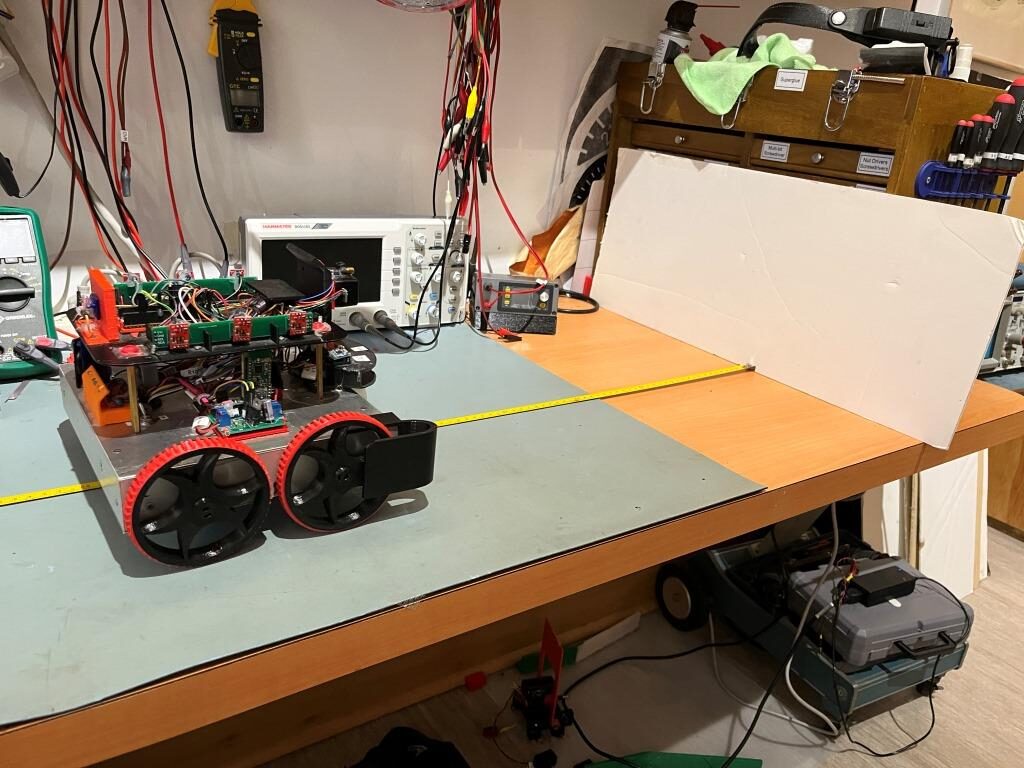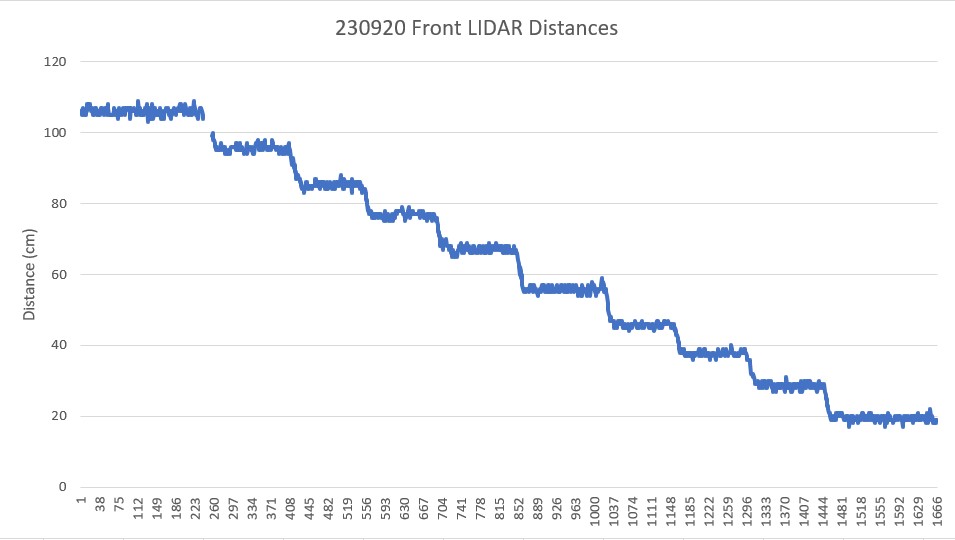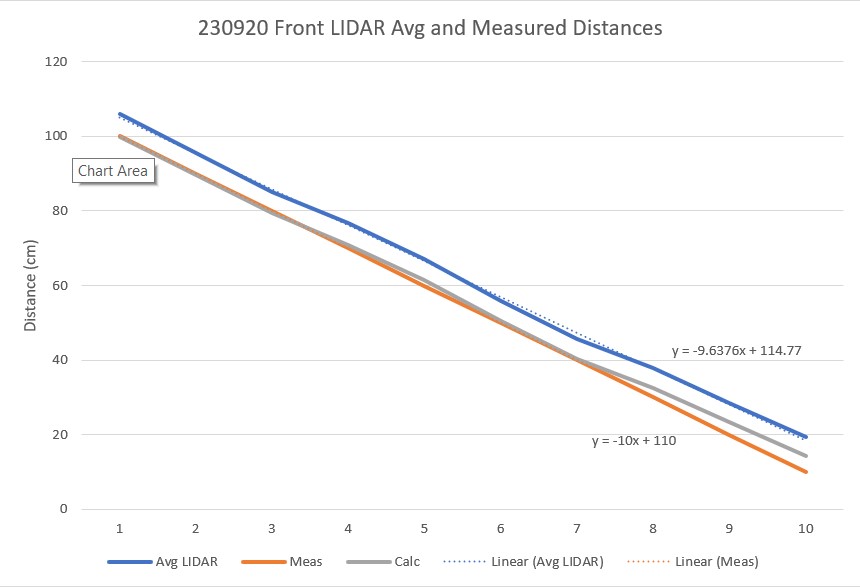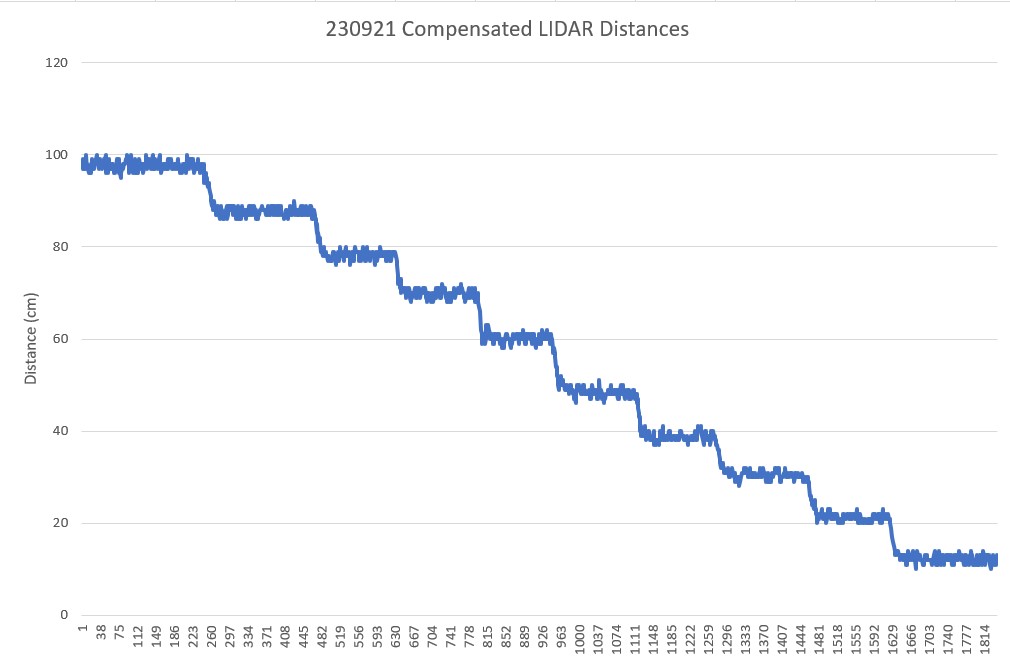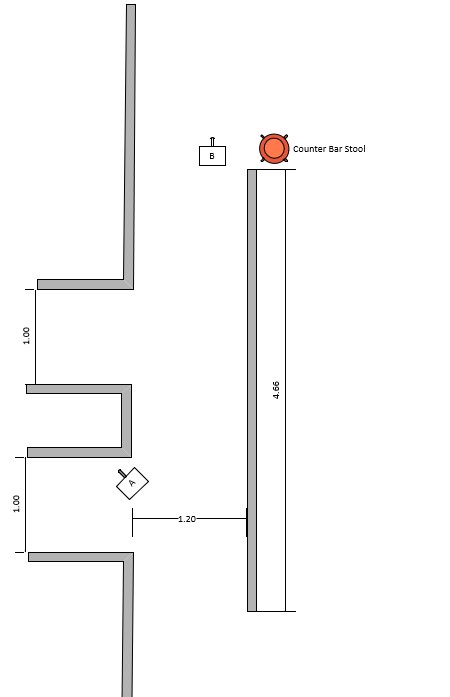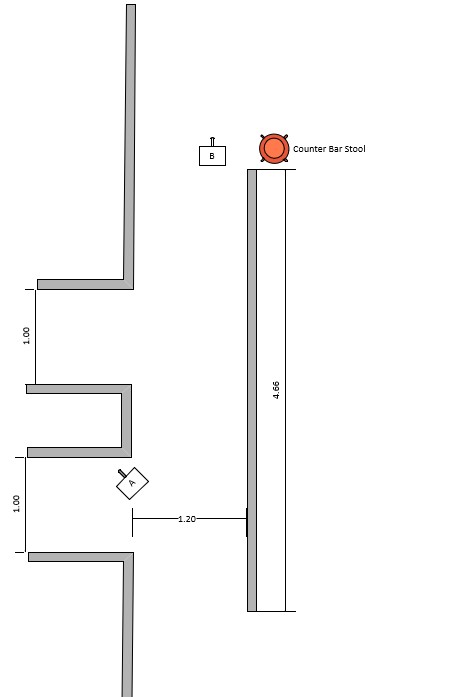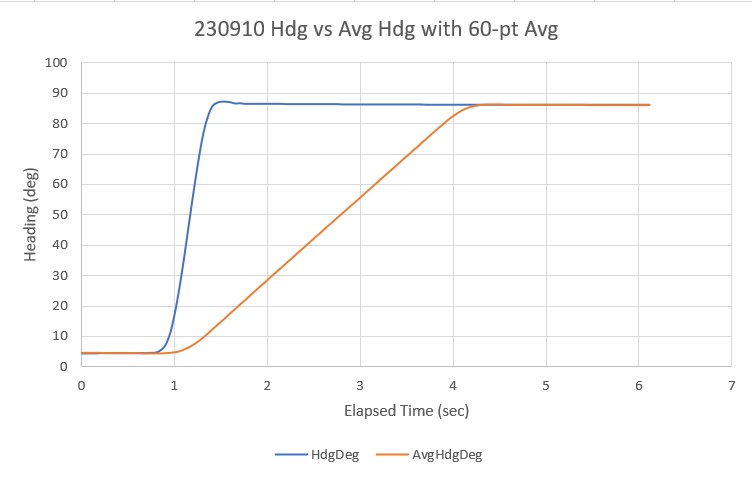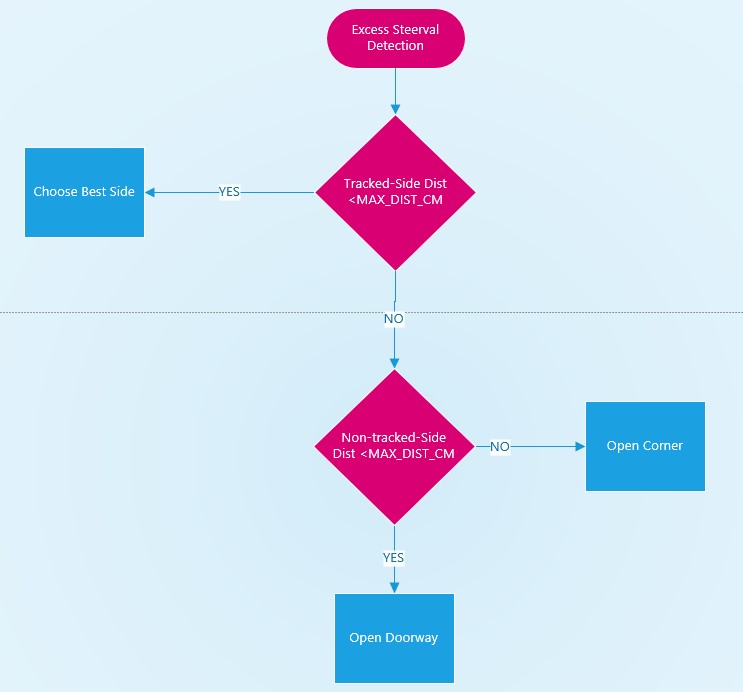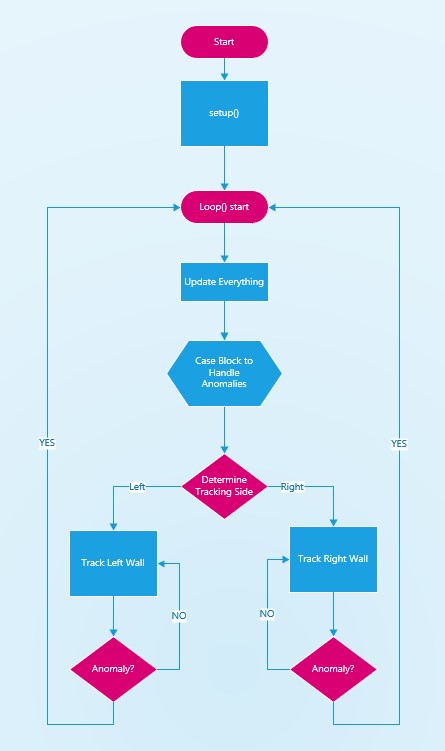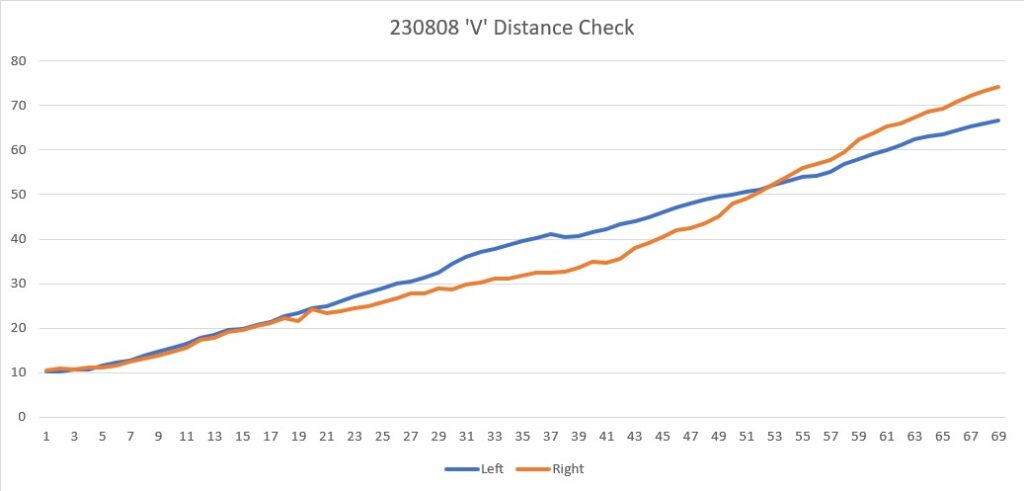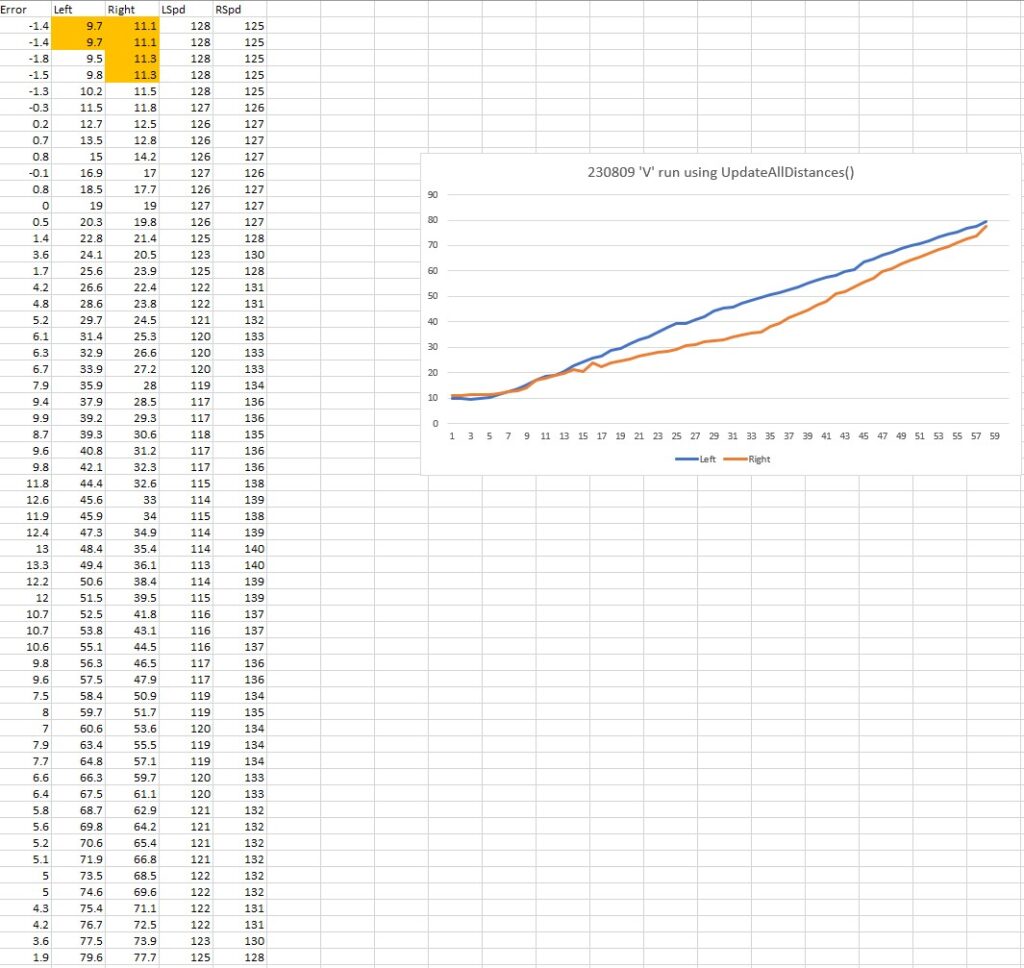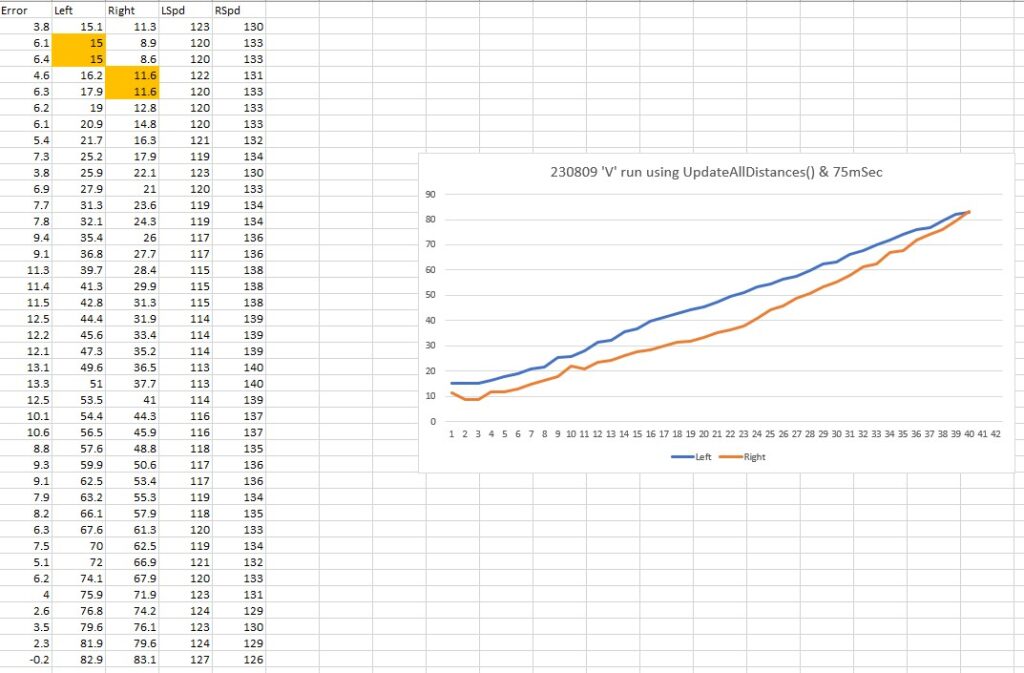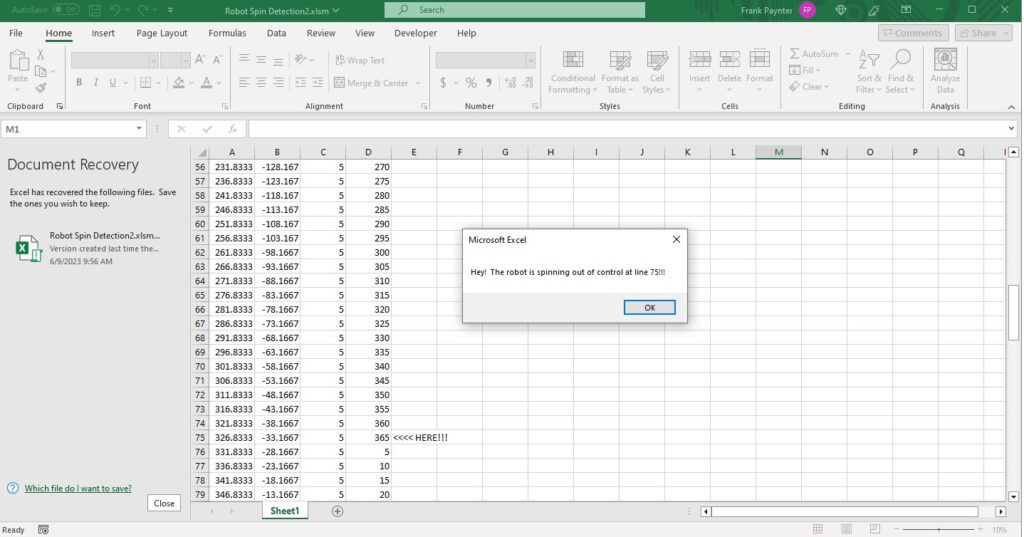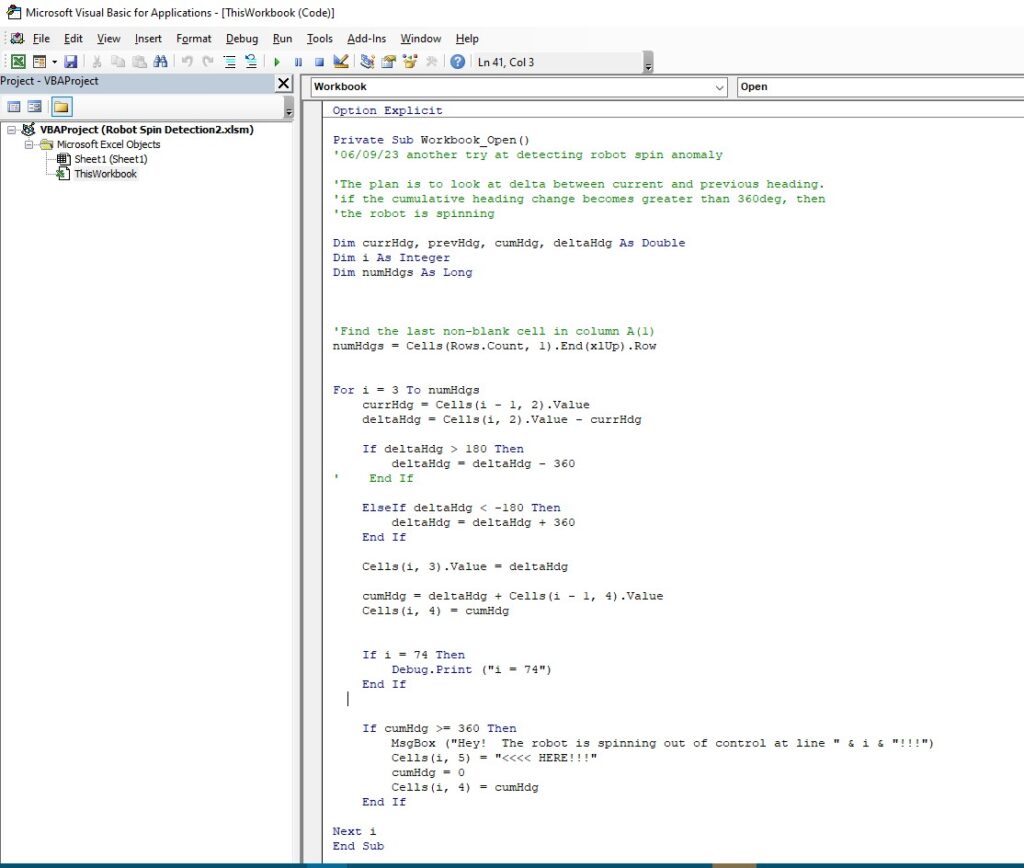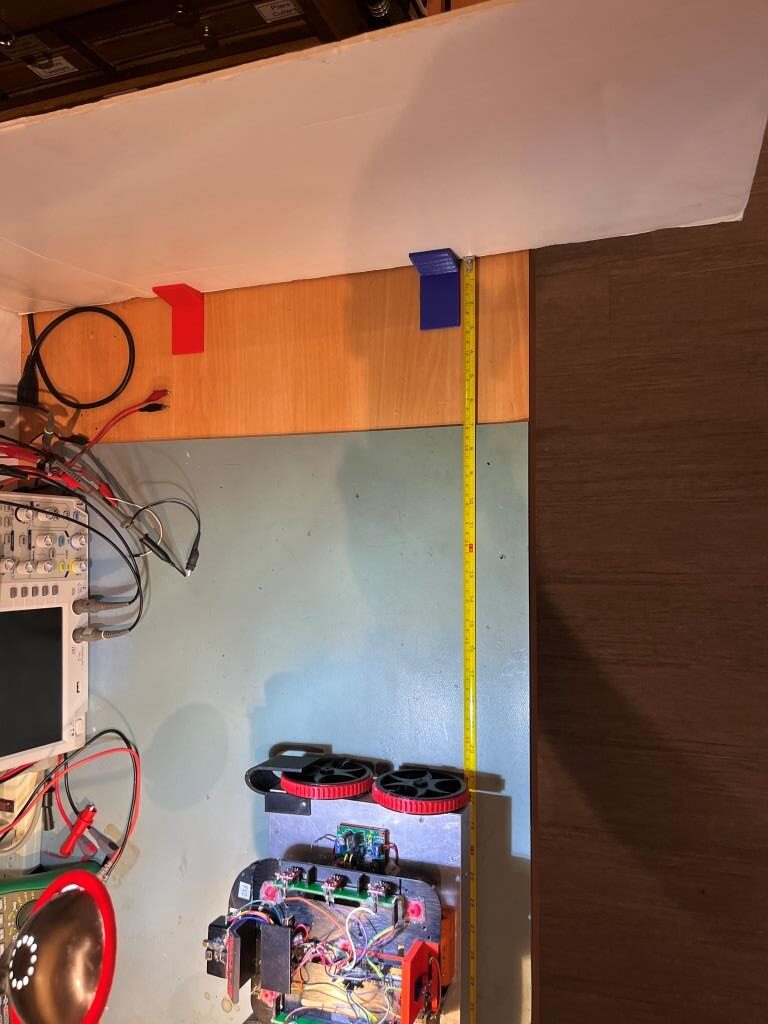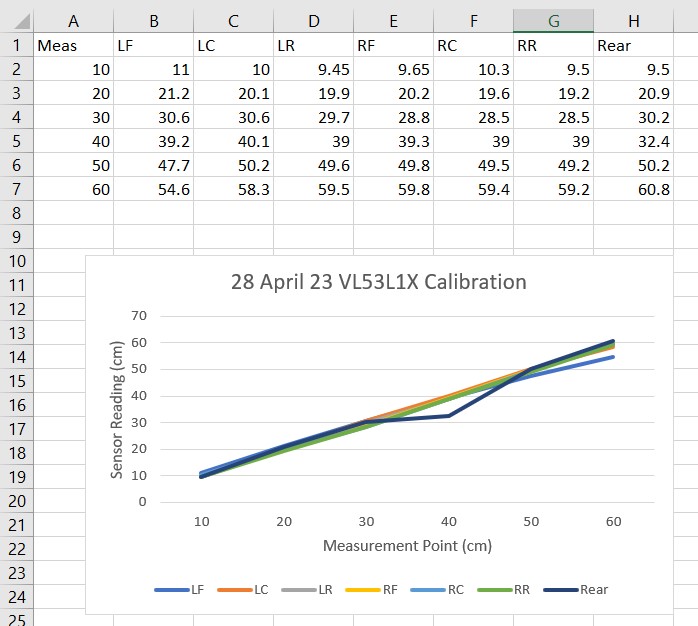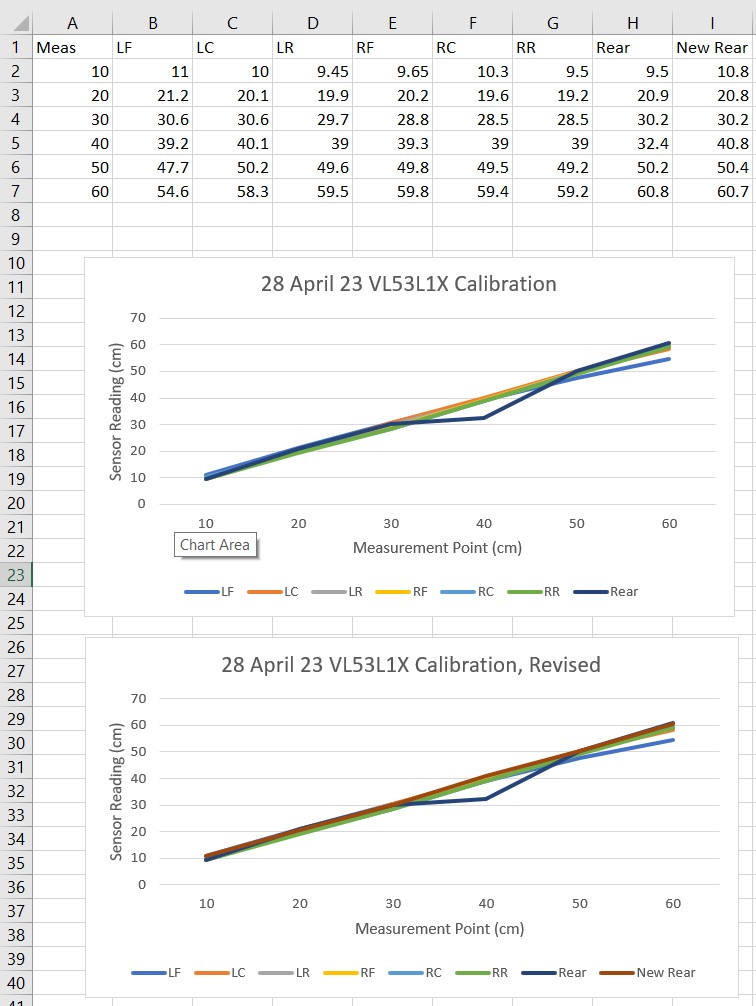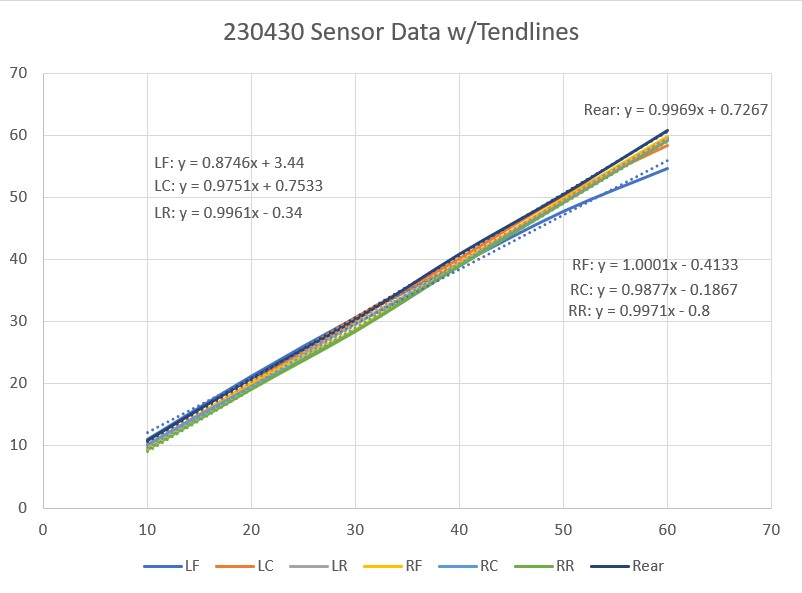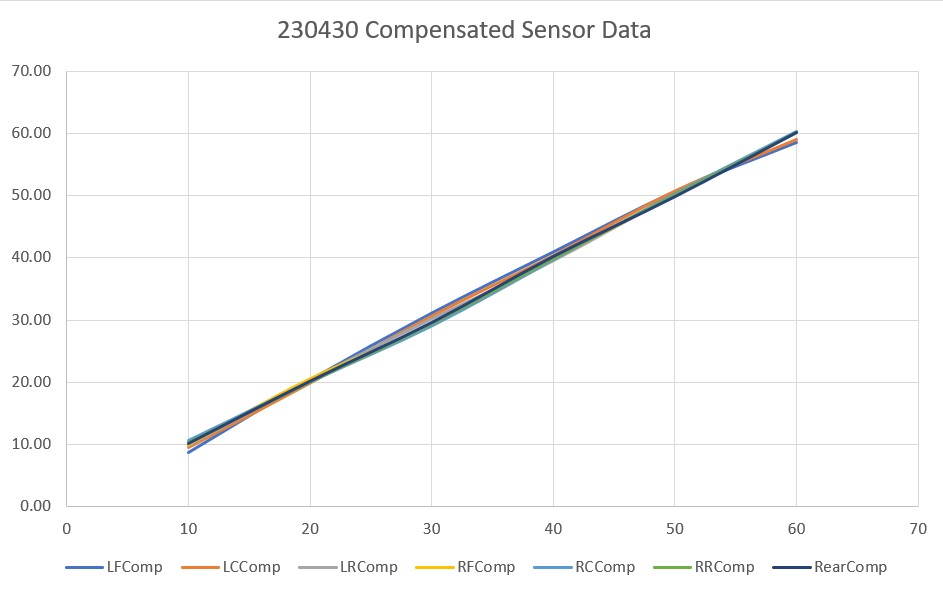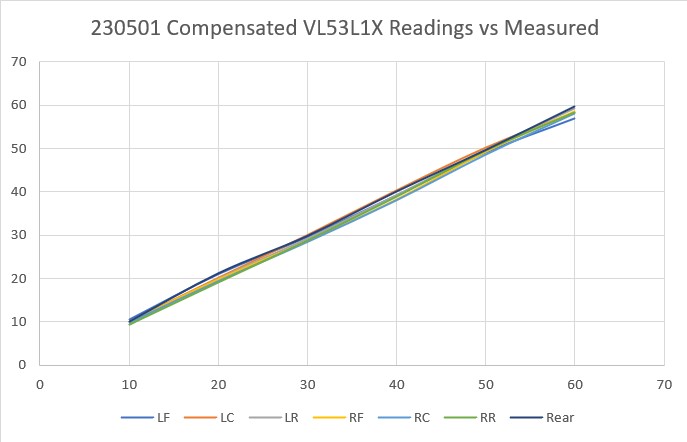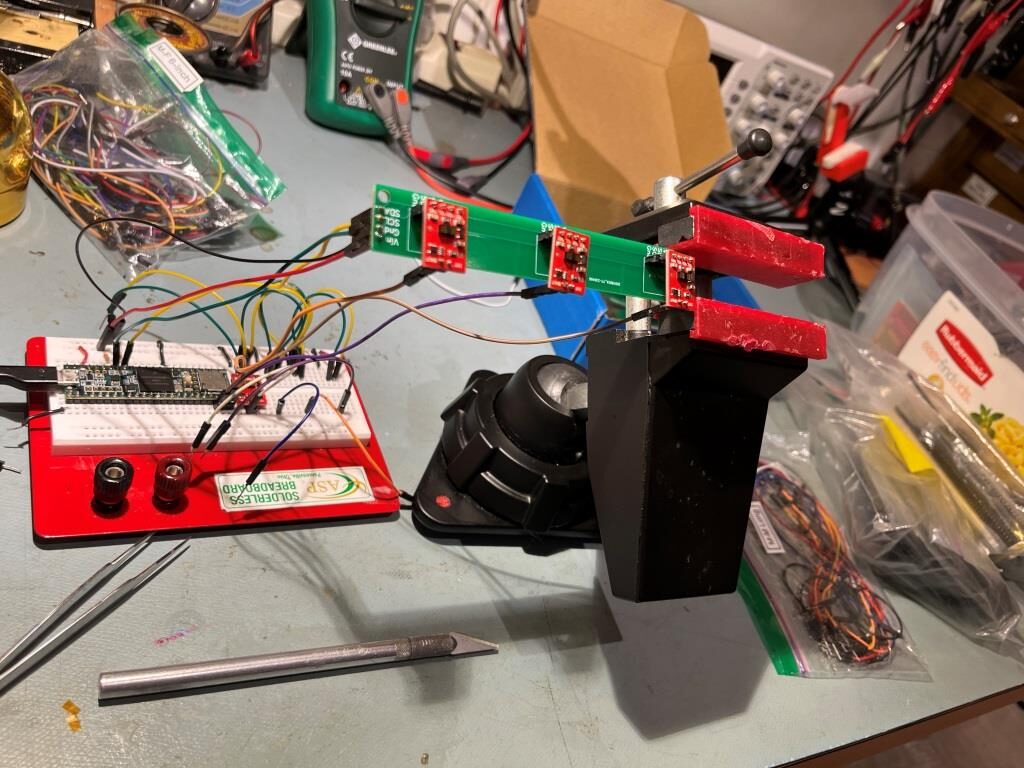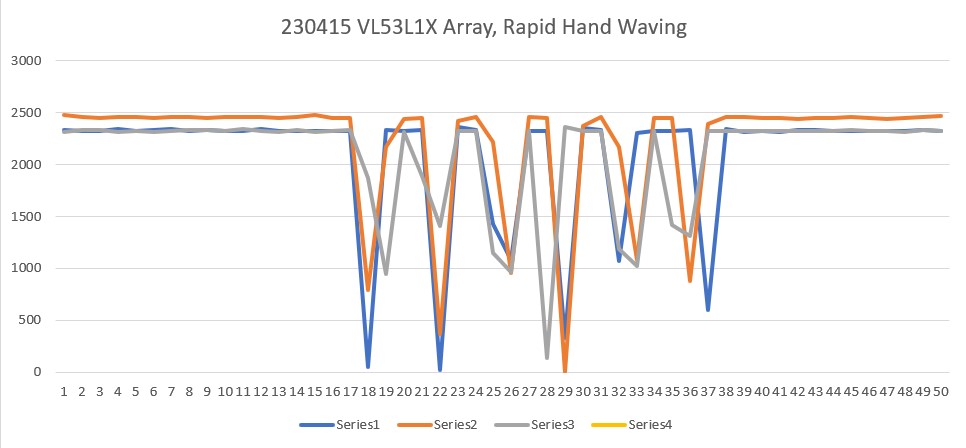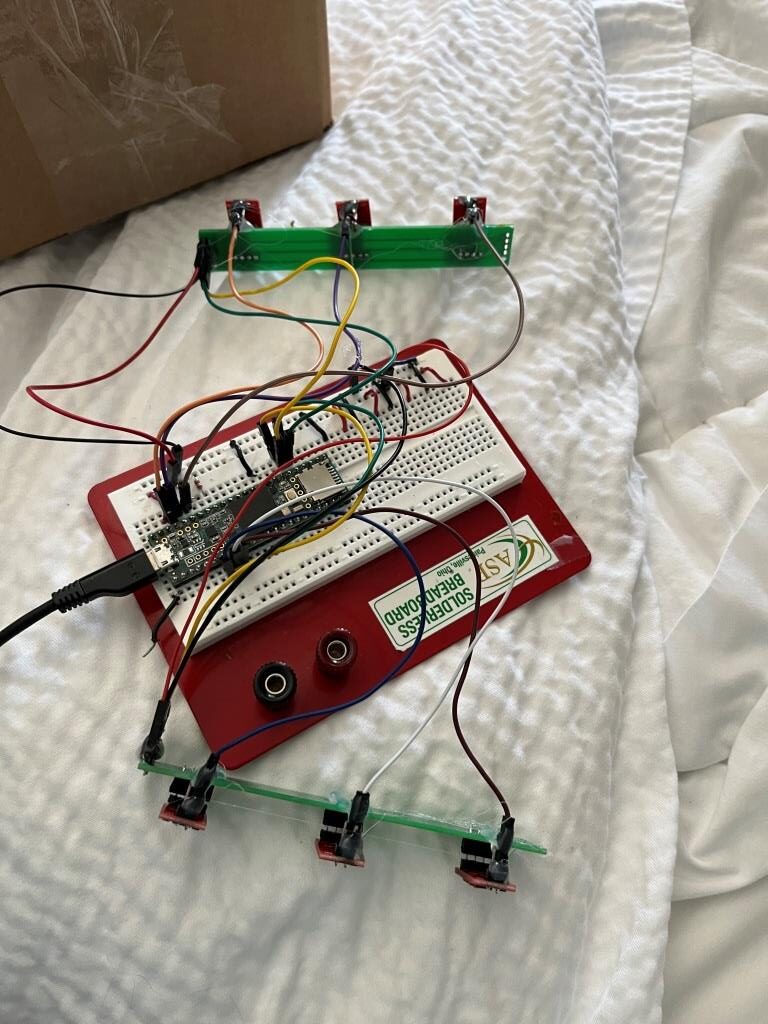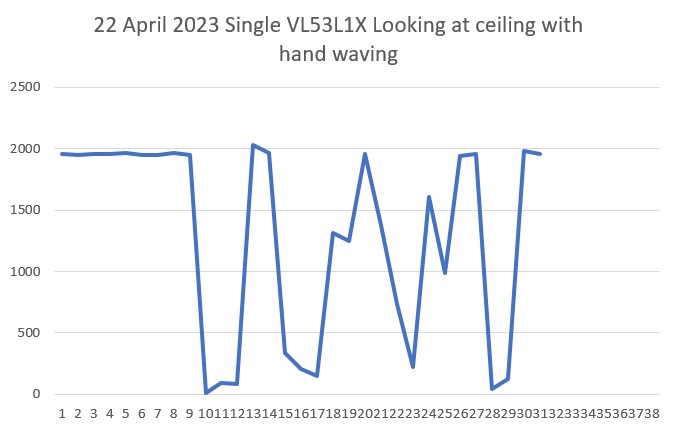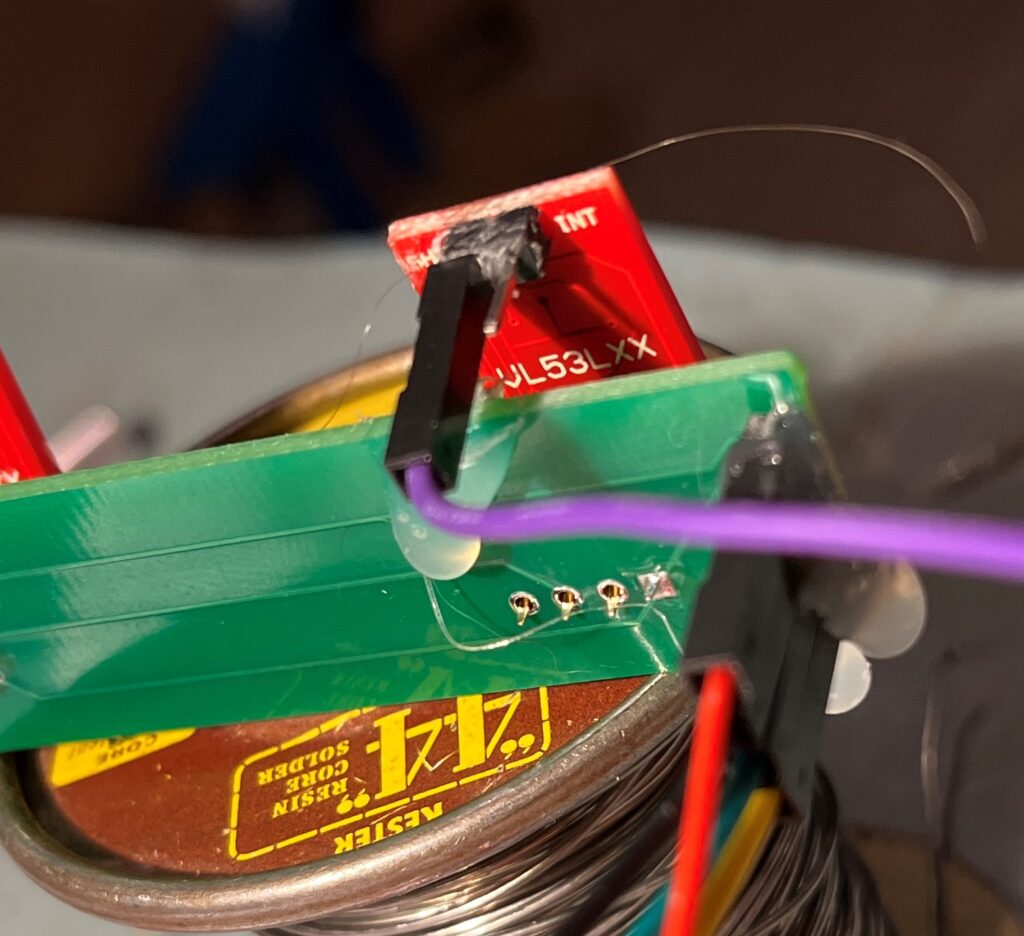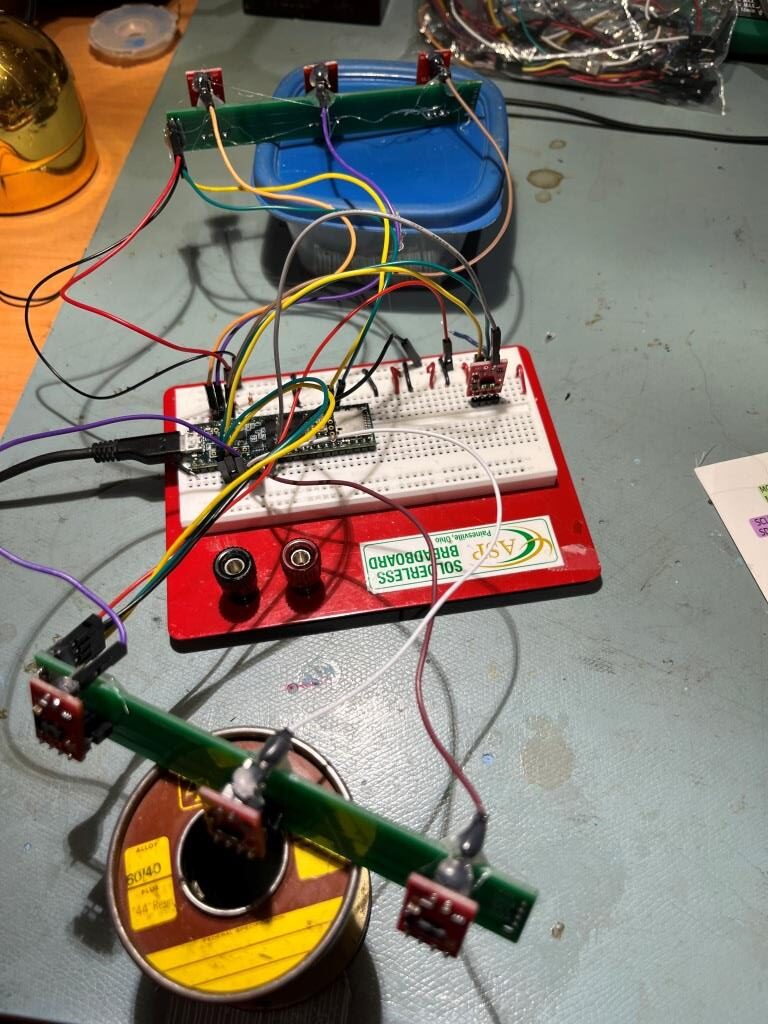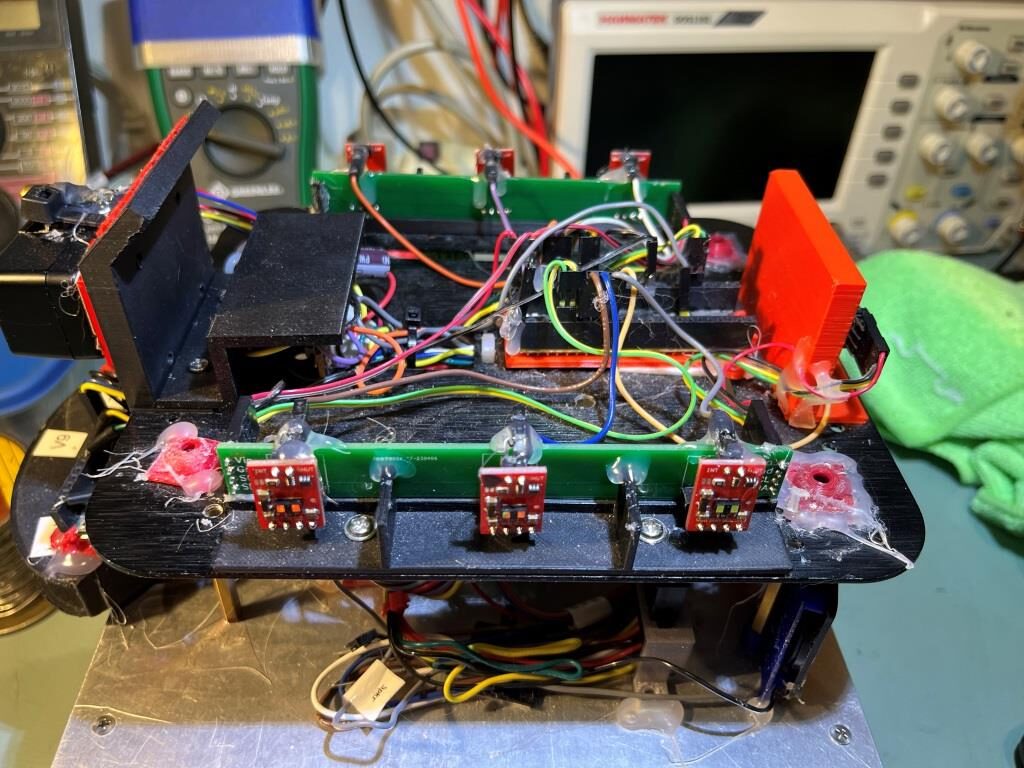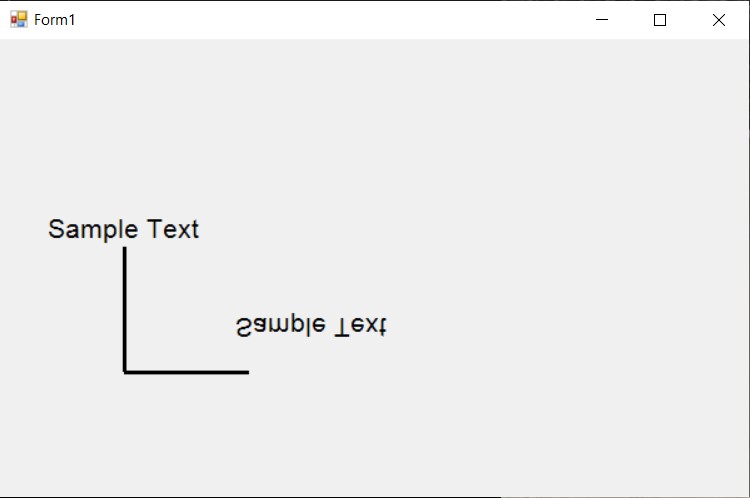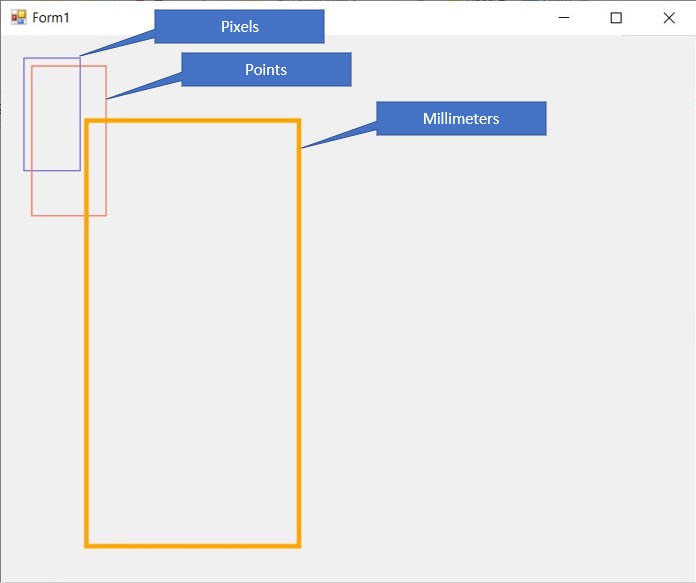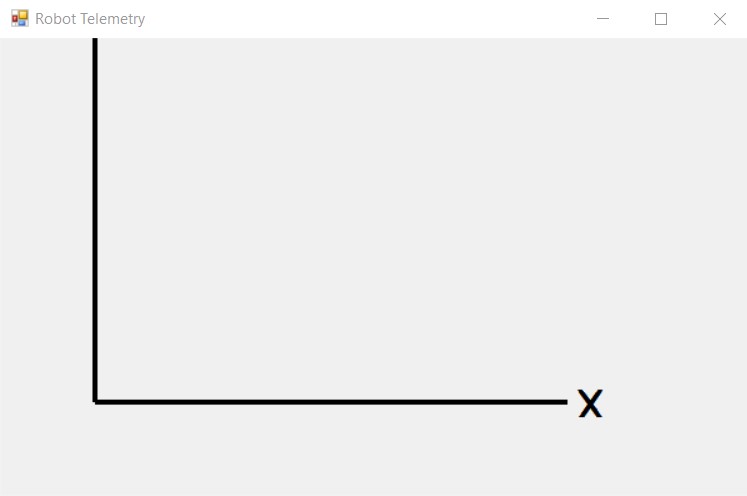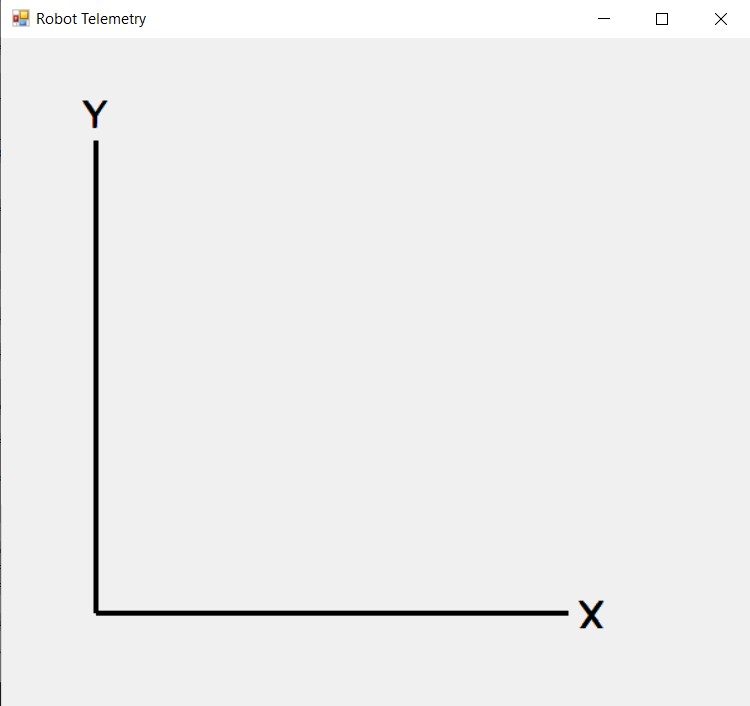gl_pSerPort now points to active Serial (USB or Wixel)
7950: Starting setup() for WallE3_Complete_V5.ino
Checking for MPU6050 IMU at I2C Addr 0x68
MPU6050 connection successful
Initializing DMP...
Enabling DMP...
DMP ready! Waiting for MPU6050 drift rate to settle...
Calibrating...Retrieving Calibration Values
Msec Hdg
10572 0.069 0.076
MPU6050 Ready at 10.57 Sec with delta = -0.007
Checking for Teensy 3.5 VL53L0X Controller at I2C addr 0x20
Teensy available at 11672 with gl_bVL53L0X_TeensyReady = 1. Waiting for Teensy setup() to finish
11675: got 1 from VL53L0X Teensy
Teensy setup() finished at 11777 mSec
VL53L0X Teensy Ready at 11780
Checking for Garmin LIDAR at Wire2 I2C addr 0x62
LIDAR Responded to query at Wire2 address 0x62!
Setting LIDAR acquisition repeat value to 0x02 for <100mSec measurement repeat delay
Initializing Front Distance Array...Done
Initializing Rear Distance Array...Done
Initializing Left/Right Distance Arrays...Done
Checking for Teensy 3.2 IRDET Controller at I2C addr 0x8
11837: IRDET Teensy Not Avail...
IRDET Teensy Ready at 11940
Fin1/Fin2/SteeringVal = 4 100 -0.3333
11942: Initializing IR Beam Total Value Averaging Array...Done
11945: Initializing IR Beam Steering Value Averaging Array...Done
Battery Voltage = 7.86
14153: End of setup(): Elapsed run time set to 0
0.0: Top of loop() - calling UpdateAllEnvironmentParameters()
Battery Voltage = 7.86
Just after first UpdateAllEnvironmentParameters() & 200mSec delay at top of loop() 0.4: gl_Left/RightCenterCm = 24.2/116.7, Left/RightSteerVal = 0.03/1.00
In HandleAnomalousConditions(NEITHER) with last anomaly code = NONE
In HandleAnomalousConditions(NEITHER) ANOMALY_NONE CASE-
0.5: gl_Left/RightCenterCm = 24.3/119.3, Left/RightSteerVal = 0.00/1.00
gl_LeftCenterCm <= gl_RightCenterCm --> Calling TrackLeftWallOffset()
TrackLeftWallOffset(350.0, 0.0, 20.0, 30) called
TrackLeftWallOffset: Start tracking offset of 30cm at 0.5
Just after CaptureWallOffset(TRACKING_LEFT, 24.3)
Sec LCen RCen Deg LF LR LStr Front Rear FVar RVar LSpd RSpd ACODE TRKDIR
0.6 23.7 118.9 0.4 23.9 24.5 -0.06 434 48 63713 12363 127 7 NONE LEFT
0.7 24.3 114.0 4.0 24.0 24.3 -0.03 412 48 56822 12212 126 23 NONE LEFT
0.8 25.4 107.1 9.1 25.3 24.5 0.08 388 52 51266 12223 83 66 NONE LEFT
0.9 26.5 106.6 11.9 26.8 25.6 0.12 371 57 47063 12360 69 80 NONE LEFT
1.0 27.6 106.5 12.2 27.8 27.1 0.07 361 61 44085 12607 71 78 NONE LEFT
1.1 29.2 104.3 11.5 29.5 27.9 0.17 363 64 42122 12949 29 120 NONE LEFT
1.2 30.1 107.3 8.5 30.4 30.1 0.03 363 68 41042 13360 63 86 NONE LEFT
1.3 30.4 126.1 5.7 30.9 30.0 0.09 374 73 40608 13802 43 106 NONE LEFT
1.4 30.9 141.8 3.2 31.3 30.6 0.07 386 76 40696 14263 50 99 NONE LEFT
1.5 30.7 146.8 0.6 31.6 30.9 0.07 390 79 41160 14723 50 99 NONE LEFT
1.6 31.1 151.1 -1.6 31.0 31.0 0.00 398 82 41884 15142 68 81 NONE LEFT
1.7 31.5 150.0 -2.0 31.3 31.9 -0.08 395 86 42906 15487 94 55 NONE LEFT
1.8 31.6 150.1 -1.1 32.1 32.2 -0.04 390 91 44064 15725 82 68 NONE LEFT
1.9 32.1 151.1 -0.6 32.1 32.2 -0.01 382 98 45194 15813 63 86 NONE LEFT
2.0 32.6 149.6 -1.7 32.7 32.3 0.04 376 102 46028 15716 47 102 NONE LEFT
2.2 32.9 149.1 -3.6 33.3 32.8 0.05 380 107 46288 15412 44 105 NONE LEFT
2.2 33.2 149.0 -4.8 32.5 33.0 -0.05 391 111 46080 15167 69 80 NONE LEFT
2.3 33.1 149.2 -5.7 32.8 32.9 -0.01 1000 115 49862 14855 58 91 NONE LEFT
2.4 33.2 148.8 -6.2 32.6 33.1 -0.05 1000 120 53425 14472 70 79 NONE LEFT
2.5 32.6 148.9 -6.5 32.8 33.0 -0.02 1000 124 56768 14014 68 81 NONE LEFT
2.7 33.0 150.0 -7.4 31.9 32.8 -0.04 624 130 58736 12861 68 81 NONE LEFT
2.8 32.4 150.1 -7.8 32.1 32.5 -0.04 545 135 57193 12158 74 75 NONE LEFT
2.9 32.5 149.7 -7.9 31.8 32.5 -0.07 523 140 55351 11367 84 65 NONE LEFT
2.9 32.0 150.1 -7.5 31.4 32.1 -0.07 839 144 55146 10484 85 64 NONE LEFT
3.0 32.0 150.1 -6.9 31.3 31.9 -0.06 503 149 52694 9507 82 67 NONE LEFT
3.1 31.1 150.5 -6.7 31.0 32.0 -0.10 1000 154 54482 8430 108 41 NONE LEFT
3.2 30.9 150.8 -6.0 30.9 31.5 -0.06 1000 159 55957 7254 96 53 NONE LEFT
3.3 31.1 150.7 -4.6 30.6 31.3 -0.07 674 163 53004 5972 92 57 NONE LEFT
3.5 31.4 150.9 -2.8 31.0 30.8 0.02 319 169 46000 3067 61 88 NONE LEFT
3.5 31.4 149.8 -2.8 31.4 31.2 0.02 318 171 44053 1427 61 89 NONE LEFT
3.6 31.3 149.6 -3.4 31.0 31.7 -0.07 297 180 45202 1584 92 57 NONE LEFT
3.7 31.5 147.7 -3.1 31.3 31.1 0.02 307 182 46326 1715 61 88 NONE LEFT
3.8 31.5 148.0 -3.3 31.4 31.2 0.02 307 186 46831 1776 61 89 NONE LEFT
4.0 31.6 147.0 -3.7 31.3 31.7 -0.04 297 193 47856 1884 81 69 NONE LEFT
4.1 31.5 146.4 -3.9 31.7 31.6 0.01 294 198 48332 1945 65 84 NONE LEFT
4.1 32.4 144.4 -3.3 31.5 31.5 0.00 659 202 48885 2007 61 88 NONE LEFT
4.2 31.9 145.8 -3.2 31.4 32.1 -0.07 277 204 49438 2063 90 59 NONE LEFT
4.3 31.7 146.1 -2.9 31.4 31.8 -0.04 283 210 50403 2176 82 67 NONE LEFT
4.4 31.8 145.4 -2.3 31.6 31.7 -0.01 271 215 51548 2262 71 78 NONE LEFT
4.5 32.1 145.6 -1.9 32.0 32.1 -0.01 264 215 52759 2308 64 85 NONE LEFT
4.6 32.1 146.0 -1.7 32.5 32.3 0.02 264 221 54674 2340 54 95 NONE LEFT
4.7 32.4 144.7 -1.3 32.7 32.5 0.02 256 224 57598 2243 54 95 NONE LEFT
4.8 32.9 145.9 -1.7 32.6 32.6 0.00 245 229 59786 2098 61 89 NONE LEFT
4.9 33.0 145.7 -2.0 32.8 32.8 -0.06 244 236 61865 1907 75 75 NONE LEFT
5.0 33.0 146.9 -2.2 33.2 32.7 0.05 233 242 63856 1700 38 111 NONE LEFT
5.1 33.3 148.7 -3.2 33.2 32.8 0.04 237 246 65766 1459 41 108 NONE LEFT
5.2 33.4 148.3 -3.8 33.4 33.4 0.00 592 253 59478 1392 53 96 NONE LEFT
5.3 33.4 148.7 -5.0 33.3 33.4 -0.01 987 258 59172 1338 57 92 NONE LEFT
5.4 33.6 148.4 -6.2 32.6 33.3 -0.07 987 263 58867 1293 77 72 NONE LEFT
5.6 33.2 148.5 -7.1 32.5 33.5 -0.10 632 272 58938 1223 94 55 NONE LEFT
5.7 32.9 149.2 -7.3 32.6 33.2 -0.06 965 276 64727 1201 82 67 NONE LEFT
5.8 32.9 149.3 -6.4 32.2 32.7 -0.05 840 281 68070 1185 78 71 NONE LEFT
5.9 32.9 148.4 -5.7 32.1 32.8 -0.07 666 285 65764 1182 85 64 NONE LEFT
5.9 32.5 149.0 -5.1 32.5 33.0 -0.05 930 288 70798 1182 78 71 NONE LEFT
6.0 32.5 149.5 -4.7 32.4 32.4 0.00 950 290 69699 1187 62 88 NONE LEFT
6.1 32.3 150.0 -4.6 31.9 32.2 -0.03 894 294 67481 1204 70 79 NONE LEFT
6.2 32.7 149.6 -4.6 32.3 32.2 0.01 946 300 71663 1233 58 91 NONE LEFT
6.4 32.3 149.9 -5.3 32.3 32.5 -0.05 937 305 80489 1294 77 72 NONE LEFT
6.5 32.6 147.7 -5.8 32.4 32.4 0.00 915 309 84257 1323 62 88 NONE LEFT
6.6 32.5 142.8 -6.3 32.2 32.3 -0.01 917 316 87750 1362 64 85 NONE LEFT
6.7 32.5 138.1 -6.9 31.9 32.4 -0.05 184 319 88813 1413 77 72 NONE LEFT
6.7 32.1 130.5 -7.4 31.9 32.5 -0.06 747 328 89631 1476 81 68 NONE LEFT
6.8 32.1 125.5 -7.3 31.5 31.9 -0.04 301 326 89674 1520 75 74 NONE LEFT
6.9 31.7 132.9 -6.7 31.6 32.0 -0.04 1000 334 94202 1584 81 68 NONE LEFT
7.0 32.0 137.6 -6.3 31.5 31.9 -0.04 887 325 96320 1612 75 74 NONE LEFT
7.2 31.2 132.2 -5.8 30.7 31.7 -0.10 1000 335 101415 1710 109 40 NONE LEFT
7.3 31.1 127.7 -4.3 30.6 30.7 -0.01 877 320 103431 1717 73 76 NONE LEFT
7.4 30.5 122.5 -2.6 29.9 30.7 -0.08 1000 289 106100 1663 101 48 NONE LEFT
7.5 30.6 129.4 -1.5 30.2 30.9 -0.07 1000 214 109803 1650 99 50 NONE LEFT
7.5 31.1 122.6 -0.4 30.6 30.8 -0.02 880 185 110169 1718 76 73 NONE LEFT
7.6 30.8 129.1 1.1 30.9 30.8 0.01 107 148 117409 2246 71 78 NONE LEFT
7.7 31.4 131.4 1.1 33.1 31.0 0.21 100 137 126986 3204 8 127 NONE LEFT
7.8 32.9 129.9 -1.2 37.5 31.7 0.58 94 153 136117 4038 0 127 NONE LEFT
8.0 36.7 104.9 -10.8 40.6 34.8 0.58 684 366 135835 4301 0 127 NONE LEFT
8.0 36.7 98.3 -15.1 40.2 34.8 0.54 266 370 135579 4574 0 127 NONE LEFT
8.1 36.9 87.0 -21.0 39.4 35.3 0.41 229 380 135837 5175 0 127 NONE LEFT
8.2 36.9 77.1 -31.9 36.6 36.8 -0.02 213 337 137171 5887 35 114 NONE LEFT
8.4 39.7 68.1 -45.2 36.6 42.3 -0.57 995 256 137869 5922 127 0 NONE LEFT
8.5 41.0 66.3 -45.1 37.0 42.8 -0.58 948 123 138188 6331 127 0 NONE LEFT
8.6 36.8 66.1 -42.1 35.1 38.0 -0.29 960 240 140895 6343 127 0 NONE LEFT
8.7 36.4 66.5 -36.8 36.4 35.7 0.07 350 273 138880 6342 17 127 NONE LEFT
8.7 36.8 67.5 -32.8 37.5 36.3 0.12 276 300 137299 6362 0 127 NONE LEFT
8.8 39.9 67.9 -33.6 40.7 38.5 0.13 243 343 137333 6529 0 127 NONE LEFT
9.0 40.8 64.5 -39.9 41.5 40.4 0.11 320 9 134024 9192 0 127 NONE LEFT
9.0 41.3 63.0 -46.1 41.0 40.9 0.01 805 34 135206 10173 0 127 NONE LEFT
9.1 41.3 60.5 -52.6 41.1 40.7 0.04 808 11 133518 11300 0 127 NONE LEFT
9.2 41.2 59.7 -61.2 41.0 41.7 -0.07 326 18 127785 13288 21 127 NONE LEFT
9.3 43.3 62.0 -70.7 42.2 44.0 -0.18 129 127 117633 13655 61 89 NONE LEFT
9.4 46.9 216.2 -75.7 43.8 46.6 -0.28 92 134 111885 13112 99 50 NONE LEFT
9.5 44.5 206.3 -75.0 42.3 45.1 -0.28 92 138 92281 12012 108 41 NONE LEFT
9.6 43.3 285.5 -73.4 40.0 43.6 -0.36 93 130 68243 12026 127 0 NONE LEFT
9.7 40.2 243.2 -69.8 37.3 40.3 -0.30 101 117 68410 12177 127 4 NONE LEFT
9.8 36.9 251.9 -62.5 34.3 36.4 -0.21 206 116 67232 12445 120 29 NONE LEFT
9.9 33.9 208.2 -57.3 32.4 33.5 -0.11 234 237 54684 11032 99 50 NONE LEFT
10.0 31.9 172.4 -52.1 31.7 31.8 -0.01 513 287 56173 9734 73 76 NONE LEFT
10.2 30.3 155.7 -47.9 30.2 30.4 0.00 758 34 64899 8709 76 73 NONE LEFT
10.2 30.8 157.5 -47.2 30.2 30.6 -0.04 794 315 70057 8325 88 61 NONE LEFT
10.3 30.7 162.1 -46.8 30.9 30.6 0.03 806 3 75182 8086 65 84 NONE LEFT
10.4 31.5 165.8 -47.2 30.8 30.9 -0.01 821 56 80518 7624 71 78 NONE LEFT
10.6 31.1 192.9 -48.1 31.4 31.6 -0.10 758 318 71507 8426 108 41 NONE LEFT
10.7 31.4 176.1 -47.4 31.6 31.4 0.02 765 330 67117 8921 63 86 NONE LEFT
10.8 31.7 198.9 -46.7 31.2 31.6 -0.04 800 315 72027 9168 80 69 NONE LEFT
10.9 31.9 187.2 -47.0 31.9 31.9 0.00 796 342 76687 9452 68 81 NONE LEFT
10.9 32.4 200.4 -47.4 32.1 31.5 0.06 779 342 80696 9582 41 108 NONE LEFT
11.0 32.9 201.0 -48.1 31.9 32.3 -0.04 757 334 84125 9515 73 77 NONE LEFT
11.1 32.5 219.9 -48.8 32.3 32.5 -0.02 699 338 86562 9728 68 81 NONE LEFT
11.2 32.8 252.7 -49.0 32.2 32.2 0.03 680 340 86754 10168 50 99 NONE LEFT
11.3 32.3 271.1 -49.3 32.1 32.5 -0.04 671 348 84621 10232 73 76 NONE LEFT
11.4 32.2 271.8 -49.7 32.3 32.9 -0.06 653 341 88357 10134 81 68 NONE LEFT
11.6 32.5 279.7 -49.8 32.0 32.7 -0.07 665 344 90961 10879 84 65 NONE LEFT
11.6 32.8 267.9 -49.7 32.2 32.4 -0.02 658 346 91313 11185 69 81 NONE LEFT
11.7 32.4 273.4 -49.7 32.4 32.3 0.03 650 344 91215 11442 51 98 NONE LEFT
11.8 32.8 280.2 -50.2 32.1 32.4 -0.03 640 338 89672 11845 71 78 NONE LEFT
11.9 32.7 289.8 -50.9 32.3 32.3 0.00 621 331 86753 11983 62 87 NONE LEFT
12.0 32.8 288.6 -51.0 32.4 31.9 0.05 619 355 84819 12137 44 105 NONE LEFT
12.1 32.6 296.0 -52.4 31.9 32.3 -0.04 605 355 80109 12336 75 75 NONE LEFT
12.2 32.4 297.2 -52.9 31.4 32.4 -0.07 582 360 74412 12450 84 65 NONE LEFT
12.3 32.2 282.4 -52.4 31.2 31.9 -0.07 585 339 67909 12264 85 64 NONE LEFT
12.4 32.2 90.8 -51.6 31.3 31.2 0.01 582 362 60625 11991 59 90 NONE LEFT
12.5 31.5 82.0 -51.1 30.9 31.5 -0.06 595 334 56747 11714 87 62 NONE LEFT
12.6 30.7 76.4 -50.6 29.8 30.7 -0.09 582 330 48443 10973 107 42 NONE LEFT
12.7 31.8 75.5 -48.9 70.7 30.3 1.00 604 179 39605 10248 0 127 EXCESS_STEER_VAL LEFT
Stopping Motors! Error Code is 8 --> EXCESS_STEER_VAL
12.8: Top of loop() - calling UpdateAllEnvironmentParameters()
Battery Voltage = 7.83
Just after first UpdateAllEnvironmentParameters() & 200mSec delay at top of loop() 13.2: gl_Left/RightCenterCm = 256.7/75.7, Left/RightSteerVal = -0.61/0.10
In HandleAnomalousConditions(LEFT) with last anomaly code = EXCESS_STEER_VAL
In HandleAnomalousConditions(LEFT) ANOMALY_EXCESS_STEER_VAL CASE-
Top of HandleExcessSteervalCase(LEFT)
14111: gl_Left/RightCenterCm = 255.1/78.5, Left/RightSteerVal = 0.99/0.13
HandleExcessSteervalCase(LEFT) open doorway block
In RotateToParallelOrientation(RIGHT)
RTPO: starting front/rear/steer avgs = 79.35/78.11/0.12
Calling SpinTurn() for angle = 7.1
In SpinTurn(CW, 7.09, 15.00) with PID = (0.7,0.3,0.0)
RTPO: ending front/rear/steer avgs = 78.90/78.45/0.05
RTPO: GetWallOrientDeg(0.05) returned ending orientation of 2.57 deg
TrackRightWallOffset(350.0, 0.0, 20.0, 30) called
TrackRightWallOffset: Start tracking offset of 30cm at 18.7
Calling CaptureWallOffset(TRACKING_RIGHT, 78.8)
Hdg Dist
In SpinTurn(CW, 90.00, 45.00) with PID = (0.7,0.3,0.0)
After SpinTurn, Hdg/Dist = 38.8/73
MTFD: at start, tgt = 30cm, curr_dist = 72, front/rear var = 83325.0/13328.0
Msec Fdist TgtD err Ival Out Speed FVar RVar
35066 73 30 -43.0 -4.3 -60.2 -60 80956 11897
35118 73 30 -43.0 -8.6 -73.1 -73 80644 11273
35168 71 30 -41.0 -12.7 -74.6 -74 80711 10697
35218 71 30 -41.0 -16.8 -78.3 -75 81109 10234
35268 70 30 -40.0 -20.8 -81.0 -75 81836 10438
35320 69 30 -39.0 -24.7 -83.4 -75 82875 10741
35370 67 30 -37.0 -28.4 -84.3 -75 84224 10597
35420 65 30 -35.0 -31.9 -84.8 -75 85862 10263
35470 63 30 -33.0 -35.2 -85.1 -75 87767 9962
35520 59 30 -29.0 -38.1 -82.4 -75 89951 10369
35570 56 30 -26.0 -40.7 -80.3 -75 92372 10859
35620 54 30 -24.0 -43.1 -79.5 -75 94988 10720
35670 51 30 -21.0 -45.2 -77.3 -75 97788 11303
35720 48 30 -18.0 -47.0 -74.6 -74 100746 11373
35770 46 30 -16.0 -48.6 -73.0 -73 103815 11347
35820 43 30 -13.0 -49.9 -70.0 -69 106982 11983
35870 40 30 -10.0 -50.9 -66.5 -66 110214 12661
35920 38 30 -8.0 -51.7 -64.1 -64 113463 13248
35970 36 30 -6.0 -52.3 -61.7 -61 116696 13699
36020 35 30 -5.0 -52.8 -60.5 -60 119860 13714
36070 34 30 -4.0 -53.2 -59.4 -59 122922 13734
36120 31 30 -1.0 -53.3 -55.4 -55 125875 13781
MTFD: Stopped with front dist = 30
In SpinTurn(CCW, 90.00, 45.00) with PID = (0.7,0.3,0.0)
In RotateToParallelOrientation(RIGHT)
RTPO: starting front/rear/steer avgs = 22.20/21.65/0.06
End of CaptureWallOffset
Just after CaptureWallOffset(TRACKING_RIGHT, 21.0)
Sec LCen RCen Deg RF RR RStr Front Rear FVar RVar LSpd RSpd ACODE TRKDIR
26.2 206.4 21.1 -47.2 22.2 21.5 0.07 699 169 128841 13792 38 111 NONE RIGHT
26.3 203.1 21.6 -48.9 22.0 22.1 -0.01 704 164 130351 13811 10 127 NONE RIGHT
26.3 209.5 21.4 -52.0 21.7 21.7 0.00 660 141 131292 13868 11 127 NONE RIGHT
26.4 211.2 21.7 -56.4 22.4 21.2 0.12 574 15 131453 14489 51 98 NONE RIGHT
26.5 200.5 22.5 -61.5 23.8 21.4 0.24 517 3 131220 15156 87 63 NONE RIGHT
26.5 196.9 24.0 -65.3 23.4 22.8 0.06 449 8 130679 15746 56 94 NONE RIGHT
26.6 122.0 22.8 -66.2 24.7 23.2 0.15 319 198 130124 15700 63 86 NONE RIGHT
26.6 132.0 23.3 -67.0 25.2 22.5 0.27 310 201 129368 15637 97 52 NONE RIGHT
26.7 146.5 24.8 -67.2 25.6 23.0 0.26 282 204 128456 15556 109 40 NONE RIGHT
26.8 118.5 25.5 -66.7 27.1 24.6 0.25 282 207 127226 15452 113 36 NONE RIGHT
26.8 181.9 26.0 -65.9 27.7 25.5 0.22 303 208 125570 15319 110 39 NONE RIGHT
26.9 136.3 27.1 -64.4 28.5 26.3 0.22 319 49 123499 15451 116 33 NONE RIGHT
27.0 135.0 27.2 -62.1 29.7 26.8 0.29 453 19 121131 15669 127 16 NONE RIGHT
27.0 163.9 28.1 -60.3 29.8 26.7 0.31 473 207 118486 15406 127 8 NONE RIGHT
27.1 209.2 28.7 -57.8 29.9 28.3 0.16 482 7 115506 15541 111 38 NONE RIGHT
27.1 181.4 29.7 -54.4 30.3 28.6 0.17 512 7 112299 15562 119 30 NONE RIGHT
27.2 98.6 28.8 -51.2 30.1 29.0 0.11 561 17 109045 15407 94 55 NONE RIGHT
27.2 83.5 29.8 -48.0 29.9 30.3 -0.04 631 168 106074 14813 56 93 NONE RIGHT
27.3 77.1 30.0 -46.0 30.2 29.9 0.03 659 172 103019 14147 83 66 NONE RIGHT
27.4 76.0 29.4 -45.7 29.9 30.1 -0.02 670 19 99666 13653 62 87 NONE RIGHT
27.5 76.7 28.6 -46.3 29.5 29.6 -0.01 666 5 95794 13077 57 92 NONE RIGHT
27.5 76.2 28.7 -47.1 29.2 29.3 -0.01 653 188 91255 12136 57 92 NONE RIGHT
27.6 76.5 28.7 -47.9 29.0 28.8 0.02 632 186 85920 11096 67 82 NONE RIGHT
27.7 77.3 28.7 -48.5 28.8 29.1 -0.03 629 183 79982 9942 51 98 NONE RIGHT
27.7 77.7 28.8 -49.5 28.5 28.3 0.02 609 190 73197 8699 67 83 NONE RIGHT
27.8 78.0 28.1 -50.3 29.1 29.2 -0.01 592 165 65565 7274 58 91 NONE RIGHT
27.9 78.3 28.3 -51.1 29.1 28.4 0.07 582 197 66030 5816 83 66 NONE RIGHT
27.9 79.3 28.6 -51.5 28.6 28.4 0.02 570 204 66168 5953 69 81 NONE RIGHT
28.0 80.0 28.3 -51.7 29.1 27.8 0.13 565 206 66066 6114 97 52 NONE RIGHT
28.0 82.3 28.7 -51.2 29.1 28.7 0.04 547 203 65603 6270 76 73 NONE RIGHT
28.1 85.5 28.6 -50.3 29.6 28.6 0.10 564 205 65090 6432 94 55 NONE RIGHT
28.2 90.4 28.5 -49.8 29.2 28.7 0.04 574 211 64460 6628 76 73 NONE RIGHT
28.2 97.1 28.2 -49.2 29.2 29.2 0.00 579 209 63658 6593 61 88 NONE RIGHT
28.3 108.2 28.4 -48.8 29.5 29.2 0.03 581 206 62645 6490 70 79 NONE RIGHT
28.3 115.2 28.6 -49.0 28.5 28.9 -0.04 579 201 61380 6585 48 101 NONE RIGHT
28.4 117.0 28.5 -49.0 28.6 29.2 -0.06 580 198 59886 6688 40 109 NONE RIGHT
28.4 125.9 28.1 -49.5 29.0 28.7 -0.01 562 203 58020 6802 56 93 NONE RIGHT
28.5 132.2 28.1 -50.3 28.9 28.5 0.04 560 198 55892 6662 74 76 NONE RIGHT
28.6 134.6 27.9 -50.7 28.8 28.7 0.01 543 198 53442 6468 58 91 NONE RIGHT
28.6 140.2 28.1 -50.4 28.6 28.4 0.02 533 202 50723 6563 67 82 NONE RIGHT
28.7 148.3 28.0 -50.2 28.4 28.3 0.01 542 208 47804 6342 64 85 NONE RIGHT
28.7 165.8 28.1 -50.2 28.1 28.5 -0.04 539 159 44640 6312 48 102 NONE RIGHT
28.8 173.9 28.0 -50.4 28.4 28.2 0.02 547 202 41264 6387 66 83 NONE RIGHT
28.8 179.1 28.3 -50.7 29.0 29.1 -0.01 538 211 37610 6133 58 91 NONE RIGHT
28.9 184.6 28.1 -50.9 29.3 28.6 0.07 530 211 33700 5827 83 66 NONE RIGHT
29.0 231.0 28.2 -51.1 29.6 28.3 0.13 525 207 29554 5551 98 51 NONE RIGHT
29.0 248.6 28.6 -50.8 29.1 28.6 0.04 522 35 25188 5583 76 73 NONE RIGHT
29.1 270.5 28.1 -50.9 29.3 28.9 0.04 521 205 20613 5636 75 75 NONE RIGHT
29.1 268.6 28.5 -51.1 28.9 29.1 -0.02 505 225 15818 5734 55 94 NONE RIGHT
29.2 267.1 28.6 -51.0 29.2 28.9 0.03 511 218 10797 5810 70 79 NONE RIGHT
29.2 268.2 28.5 -51.3 29.0 28.3 0.07 503 214 10278 5871 84 65 NONE RIGHT
29.3 270.5 28.3 -51.2 29.3 29.0 0.03 495 217 9704 5939 72 77 NONE RIGHT
29.3 267.4 28.4 -51.1 29.5 28.9 0.06 501 221 9364 6008 81 68 NONE RIGHT
29.4 265.6 28.7 -51.1 29.4 28.8 0.07 497 210 9331 5626 85 64 NONE RIGHT
29.4 263.9 28.7 -51.0 29.1 29.2 0.02 496 201 9345 5123 69 81 NONE RIGHT
29.5 258.9 28.7 -50.6 29.6 29.2 0.04 501 192 9243 4606 74 75 NONE RIGHT
29.5 191.5 28.9 -50.5 29.0 29.1 -0.01 500 29 8397 4984 58 91 NONE RIGHT
29.6 91.3 28.5 -50.3 29.8 29.3 0.05 496 37 7452 5293 77 72 NONE RIGHT
29.6 78.8 28.9 -50.3 29.1 29.1 0.00 493 151 6215 5264 62 88 NONE RIGHT
29.7 76.8 28.6 -50.5 29.4 29.0 0.04 485 211 4959 5269 74 75 NONE RIGHT
29.7 75.4 28.6 -50.4 29.3 29.0 0.03 484 211 3884 5275 71 78 NONE RIGHT
29.8 75.5 28.8 -50.4 29.5 29.0 0.05 486 162 2929 5003 78 71 NONE RIGHT
29.8 75.9 29.1 -50.2 29.6 29.0 0.06 485 209 2828 4589 88 61 NONE RIGHT
29.9 75.8 28.9 -50.0 29.7 29.3 0.04 483 214 2800 4601 75 74 NONE RIGHT
29.9 76.0 28.9 -49.6 32.5 29.6 0.29 489 214 2783 4087 127 12 NONE RIGHT
30.0 76.5 28.7 -49.5 29.5 29.3 0.02 490 17 2824 4015 72 77 NONE RIGHT
30.0 76.5 28.9 -48.4 29.3 29.2 0.01 491 106 2883 3608 64 85 NONE RIGHT
30.1 76.2 28.6 -47.9 29.5 29.6 -0.03 493 219 2789 3643 51 98 NONE RIGHT
30.1 76.5 29.1 -47.7 29.2 29.3 -0.01 489 222 2570 3682 63 86 NONE RIGHT
30.2 76.9 28.4 -48.1 28.9 29.2 -0.03 490 226 2270 3206 51 98 NONE RIGHT
30.2 76.5 28.3 -48.1 28.6 29.3 -0.07 490 223 1966 2593 37 112 NONE RIGHT
30.3 76.9 28.3 -48.5 28.9 29.2 -0.03 480 225 1722 2622 49 100 NONE RIGHT
30.3 76.9 28.1 -49.0 28.6 28.9 -0.03 471 220 1570 2642 50 99 NONE RIGHT
30.4 77.1 28.7 -49.7 28.7 28.7 0.00 460 226 1436 2668 60 89 NONE RIGHT
30.4 76.9 28.4 -50.3 28.7 28.8 -0.01 455 220 1371 2687 57 92 NONE RIGHT
30.5 76.9 28.6 -50.9 29.0 28.8 0.02 455 206 1344 2679 67 82 NONE RIGHT
30.5 77.4 28.4 -51.4 30.8 28.9 0.19 441 201 1367 2681 110 39 NONE RIGHT
30.6 77.1 28.0 -51.7 35.1 28.5 0.66 428 194 1446 2677 127 0 NONE RIGHT
RightSteer = 1.0, result = TRUE
30.6 77.1 30.2 -51.5 44.9 28.5 1.00 420 214 1548 2684 127 0 EXCESS_STEER_VAL RIGHT
Stopping Motors! Error Code is 8 --> EXCESS_STEER_VAL
30.6: Top of loop() - calling UpdateAllEnvironmentParameters()
Battery Voltage = 7.82
Just after first UpdateAllEnvironmentParameters() & 200mSec delay at top of loop() 31.1: gl_Left/RightCenterCm = 76.9/49.9, Left/RightSteerVal = -0.02/0.36
In HandleAnomalousConditions(RIGHT) with last anomaly code = EXCESS_STEER_VAL
In HandleAnomalousConditions(RIGHT) ANOMALY_EXCESS_STEER_VAL CASE-
Top of HandleExcessSteervalCase(RIGHT)
31980: gl_Left/RightCenterCm = 79.1/94.1, Left/RightSteerVal = -0.04/-1.00
In ChooseBetterTrackingSide with avg hdg = -50.0
TurnToHdgDeg: currHdg = -48.0, tgtHdg = -50.0, retries = 0
In SpinTurn(CCW, 1.99, 45.00) with PID = (0.7,0.3,0.0)
In SpinTurn(CCW, 10.00, 45.00) with PID = (0.7,0.3,0.0)
In ChooseBetterTrackingSide: hdg = -58.1, left/right dists = 275.0/85.7, numleftright = 0/1
In SpinTurn(CCW, 10.00, 45.00) with PID = (0.7,0.3,0.0)
In ChooseBetterTrackingSide: hdg = -69.0, left/right dists = 244.0/305.3, numleftright = 0/1
In SpinTurn(CCW, 10.00, 45.00) with PID = (0.7,0.3,0.0)
In ChooseBetterTrackingSide: hdg = -79.4, left/right dists = 639.0/308.0, numleftright = 0/1
In SpinTurn(CCW, 10.00, 45.00) with PID = (0.7,0.3,0.0)
In ChooseBetterTrackingSide: hdg = -89.9, left/right dists = 117.0/246.2, numleftright = 0/1
In SpinTurn(CCW, 10.00, 45.00) with PID = (0.7,0.3,0.0)
In ChooseBetterTrackingSide: hdg = -99.5, left/right dists = 98.0/223.8, numleftright = 1/1
In SpinTurn(CCW, 10.00, 45.00) with PID = (0.7,0.3,0.0)
In ChooseBetterTrackingSide: hdg = -109.5, left/right dists = 86.0/198.1, numleftright = 2/1
In SpinTurn(CCW, 10.00, 45.00) with PID = (0.7,0.3,0.0)
In ChooseBetterTrackingSide: hdg = -120.9, left/right dists = 77.0/182.2, numleftright = 3/1
In SpinTurn(CCW, 10.00, 45.00) with PID = (0.7,0.3,0.0)
In ChooseBetterTrackingSide: hdg = -130.8, left/right dists = 75.0/179.8, numleftright = 4/1
In SpinTurn(CCW, 10.00, 45.00) with PID = (0.7,0.3,0.0)
In ChooseBetterTrackingSide: hdg = -140.3, left/right dists = 75.0/312.2, numleftright = 5/1
TurnToHdgDeg: currHdg = -141.8, tgtHdg = -50.0, retries = 0
In SpinTurn(CW, 91.87, 45.00) with PID = (0.7,0.3,0.0)
ChooseBetterTrackingSide 'left' block with numleft/rightwallsegments = 5/1
HandleExcessSteervalCase(LEFT): ChooseBetterTrackingSide() returned �
TrackLeftWallOffset(350.0, 0.0, 20.0, 30) called
TrackLeftWallOffset: Start tracking offset of 30cm at 37.1
Calling CaptureWallOffset(TRACKING_LEFT, 171.5)
Hdg Dist
In SpinTurn(CCW, 90.00, 45.00) with PID = (0.7,0.3,0.0)
After SpinTurn, Hdg/Dist = -138.2/77
MTFD: at start, tgt = 30cm, curr_dist = 76, front/rear var = 83325.0/13328.0
Msec Fdist TgtD err Ival Out Speed FVar RVar
53487 78 30 -48.0 -4.8 -67.2 -67 80770 12344
53537 77 30 -47.0 -9.5 -80.2 -75 80390 11937
53587 76 30 -46.0 -14.1 -83.3 -75 80372 11583
53637 75 30 -45.0 -18.6 -86.3 -75 80702 11283
53687 74 30 -44.0 -23.0 -89.2 -75 81363 11044
53740 72 30 -42.0 -27.2 -90.6 -75 82352 11163
53790 72 30 -42.0 -31.4 -94.4 -75 83618 11422
53840 69 30 -39.0 -35.3 -94.4 -75 85191 11287
53890 67 30 -37.0 -39.0 -94.9 -75 87033 11181
53940 65 30 -35.0 -42.5 -95.4 -75 89120 11112
53990 61 30 -31.0 -45.6 -92.9 -75 91463 11262
54040 60 30 -30.0 -48.6 -93.8 -75 93987 11753
54090 57 30 -27.0 -51.3 -92.4 -75 96697 11816
54140 53 30 -23.0 -53.6 -88.9 -75 99585 12377
54190 51 30 -21.0 -55.7 -87.6 -75 102586 12962
54240 49 30 -19.0 -57.6 -86.5 -75 105671 13339
54290 47 30 -17.0 -59.3 -85.2 -75 108810 13421
54340 44 30 -14.0 -60.7 -82.3 -75 111986 13481
54389 40 30 -10.0 -61.7 -77.5 -75 115182 13541
54439 37 30 -7.0 -62.4 -73.5 -73 118345 13604
54489 36 30 -6.0 -63.0 -72.2 -72 121408 13668
54540 34 30 -4.0 -63.4 -69.8 -69 124351 13725
54590 31 30 -1.0 -63.5 -65.6 -65 127150 13779
MTFD: Stopped with front dist = 30
In SpinTurn(CW, 90.00, 45.00) with PID = (0.7,0.3,0.0)
In RotateToParallelOrientation(LEFT)
End of CaptureWallOffset
Just after CaptureWallOffset(TRACKING_LEFT, 22.0)
Sec LCen RCen Deg LF LR LStr Front Rear FVar RVar LSpd RSpd ACODE TRKDIR
44.6 21.8 149.9 -48.4 22.3 22.6 -0.03 243 178 128836 13783 127 2 NONE LEFT
44.8 22.2 155.1 -41.6 23.1 22.3 0.07 371 173 128086 13769 108 41 NONE LEFT
44.9 23.0 133.7 -34.3 22.5 23.2 -0.07 479 74 126472 14129 127 4 NONE LEFT
45.0 23.8 117.9 -28.8 27.2 22.1 0.51 501 44 124338 14618 0 127 NONE LEFT
45.0 25.2 115.8 -28.7 25.3 25.3 0.00 509 51 122972 14777 103 46 NONE LEFT
45.2 27.0 118.3 -29.9 27.6 25.6 0.20 499 40 117004 14984 38 111 NONE LEFT
45.3 28.1 121.2 -32.7 29.5 27.1 0.24 481 54 111183 14582 19 127 NONE LEFT
45.4 29.6 155.4 -37.2 30.1 28.5 0.16 471 37 103524 13873 31 118 NONE LEFT
45.4 30.1 157.3 -42.6 30.2 28.9 0.21 397 20 93338 12895 15 127 NONE LEFT
45.6 30.8 155.2 -48.9 30.5 29.9 0.06 279 151 80291 10985 54 96 NONE LEFT
45.6 30.8 223.6 -52.9 30.5 30.7 -0.05 218 213 64167 8973 89 60 NONE LEFT
45.8 31.4 275.5 -55.5 30.7 31.7 -0.10 251 229 44258 6748 107 42 NONE LEFT
45.9 31.6 296.4 -55.3 30.3 31.4 -0.11 248 233 32385 4182 112 37 NONE LEFT
46.0 31.1 300.2 -54.4 30.3 30.6 -0.03 251 238 31501 4899 78 71 NONE LEFT
46.1 30.0 316.9 -53.5 29.5 30.5 -0.10 227 243 30505 5589 109 40 NONE LEFT
46.2 30.0 293.2 -52.2 29.2 30.0 -0.07 206 239 29434 6182 99 50 NONE LEFT
46.2 29.8 296.8 -50.5 29.2 29.8 -0.05 183 240 28370 6380 100 49 NONE LEFT
46.3 29.6 265.3 -48.5 29.5 29.6 -0.01 189 189 27202 6629 84 65 NONE LEFT
46.4 29.9 290.0 -47.7 29.6 29.9 -0.03 199 222 25851 6824 92 57 NONE LEFT
46.5 30.1 291.0 -47.5 29.8 29.9 -0.01 208 188 24304 6646 77 72 NONE LEFT
46.6 30.3 273.8 -47.6 30.6 30.4 0.02 195 184 22643 5972 68 81 NONE LEFT
46.7 30.2 305.8 -47.5 30.1 30.5 -0.04 203 95 20787 5827 87 62 NONE LEFT
46.8 31.0 323.1 -47.0 30.8 31.0 -0.02 206 164 18749 5798 76 73 NONE LEFT
46.9 31.4 308.4 -46.3 31.0 30.9 0.00 231 176 16385 5814 67 82 NONE LEFT
47.0 31.2 267.6 -46.7 31.2 31.0 0.02 222 147 13840 5804 61 89 NONE LEFT
47.1 31.3 276.1 -47.0 31.7 31.3 0.06 205 18 14038 6228 47 102 NONE LEFT
47.2 32.1 311.8 -47.6 32.1 31.7 0.04 185 91 14296 6553 48 102 NONE LEFT
47.3 32.6 298.8 -48.4 31.9 32.0 -0.01 157 93 13702 6493 63 86 NONE LEFT
47.4 32.6 325.6 -49.1 32.3 32.4 -0.01 139 91 12352 6240 64 85 NONE LEFT
47.5 32.7 310.4 -49.6 35.2 32.1 0.31 129 95 10528 5943 0 127 NONE LEFT
47.6 35.7 320.4 -51.2 61.3 32.0 1.00 113 98 8520 5577 0 127 EXCESS_STEER_VAL LEFT
Stopping Motors! Error Code is 8 --> EXCESS_STEER_VAL
47.7: Top of loop() - calling UpdateAllEnvironmentParameters()
Battery Voltage = 7.80
Just after first UpdateAllEnvironmentParameters() & 200mSec delay at top of loop() 48.1: gl_Left/RightCenterCm = 58.0/150.0, Left/RightSteerVal = 1.00/-1.00
In HandleAnomalousConditions(LEFT) with last anomaly code = EXCESS_STEER_VAL
In HandleAnomalousConditions(LEFT) ANOMALY_EXCESS_STEER_VAL CASE-
Top of HandleExcessSteervalCase(LEFT)
48945: gl_Left/RightCenterCm = 120.4/132.5, Left/RightSteerVal = 1.00/0.98
HandleExcessSteervalCase(LEFT) open corner block
In SpinTurn(CCW, 90.00, 45.00) with PID = (0.7,0.3,0.0)
HandleExcessSteervalCase(LEFT) open corner block after turn and move: gl_Left/RightCenterCm = 26.0/118.3, Left/RightSteerVal = -0.31/1.00
TrackLeftWallOffset(350.0, 0.0, 20.0, 30) called
TrackLeftWallOffset: Start tracking offset of 30cm at 52.1
Just after CaptureWallOffset(TRACKING_LEFT, 26.0)
Sec LCen RCen Deg LF LR LStr Front Rear FVar RVar LSpd RSpd ACODE TRKDIR
52.2 23.8 94.6 -160.4 21.4 24.9 -0.22 63 172 3805 4752 127 0 NONE LEFT
52.3 21.6 150.5 -157.3 22.1 23.7 -0.29 68 201 3047 3944 127 0 NONE LEFT
52.4 19.7 125.9 -153.2 17.8 21.6 -0.38 83 192 3234 3907 127 0 NONE LEFT
52.5 18.0 133.9 -146.5 17.5 18.8 -0.13 162 204 3209 3894 127 0 NONE LEFT
52.6 16.4 112.8 -138.9 16.2 17.4 -0.12 524 163 5506 3750 127 0 NONE LEFT
52.7 16.1 101.6 -131.7 15.9 16.4 -0.06 534 153 10203 3555 127 0 NONE LEFT
52.8 16.9 91.2 -121.9 17.5 17.2 0.03 330 213 12562 3392 127 0 NONE LEFT
52.9 17.9 85.7 -118.0 18.2 17.9 0.03 239 47 12580 3509 127 0 NONE LEFT
53.0 21.5 84.2 -109.3 22.2 20.2 0.20 162 35 12594 3817 76 73 NONE LEFT
53.1 23.5 87.4 -106.8 24.1 20.9 0.32 139 30 12704 3901 31 118 NONE LEFT
53.2 23.8 85.3 -110.2 26.1 22.8 0.33 152 31 12782 4038 34 115 NONE LEFT
53.3 25.1 83.2 -116.3 27.3 24.0 0.33 178 43 12800 3926 22 127 NONE LEFT
53.4 25.3 87.9 -122.3 26.8 24.6 0.23 227 50 12820 3802 42 107 NONE LEFT
53.5 25.7 93.1 -125.7 27.0 25.0 0.20 279 58 12968 3755 53 96 NONE LEFT
53.6 26.4 107.6 -129.3 26.6 25.9 0.09 475 92 15302 3663 71 78 NONE LEFT
53.7 26.3 120.7 -130.3 26.4 26.0 0.04 493 224 18378 3867 88 62 NONE LEFT
53.8 27.1 120.8 -130.1 26.9 26.9 0.00 486 189 22584 4538 95 54 NONE LEFT
53.9 27.7 125.2 -129.3 28.1 27.7 0.04 479 183 25034 5121 81 68 NONE LEFT
54.0 28.6 127.9 -129.5 28.7 27.7 0.10 471 97 27019 4904 54 95 NONE LEFT
54.1 29.0 132.6 -130.9 28.9 28.4 0.05 475 81 28650 4762 64 85 NONE LEFT
54.2 28.8 137.1 -132.2 29.5 29.1 0.03 477 90 29756 4770 78 71 NONE LEFT
54.3 29.3 146.8 -132.6 30.0 29.7 0.03 471 100 30318 4752 71 78 NONE LEFT
54.4 30.0 149.9 -132.9 30.3 29.5 0.08 474 125 30415 4718 48 101 NONE LEFT
54.5 30.2 115.1 -134.3 30.2 29.7 0.05 465 84 29932 4886 56 93 NONE LEFT
54.6 30.7 65.7 -136.9 30.4 30.3 0.01 456 239 28260 5068 71 78 NONE LEFT
54.7 30.9 60.9 -138.1 30.8 29.9 0.09 450 241 25703 5510 45 104 NONE LEFT
54.8 29.9 62.3 -139.4 30.6 30.5 0.01 447 152 22686 5528 78 71 NONE LEFT
54.9 29.9 62.6 -139.6 29.9 30.1 -0.02 439 176 19446 5483 88 61 NONE LEFT
55.0 30.3 62.8 -139.2 29.6 30.0 -0.04 434 219 16998 5445 89 60 NONE LEFT
55.1 29.9 62.1 -138.6 30.2 30.0 -0.02 431 180 16233 5556 87 62 NONE LEFT
55.2 29.6 64.0 -138.8 29.3 29.5 -0.02 425 109 15472 5544 89 61 NONE LEFT
55.3 29.9 64.2 -138.5 29.3 29.6 -0.03 423 220 15127 5722 92 57 NONE LEFT
55.4 29.9 64.0 -137.6 29.3 29.2 0.01 418 45 14002 5551 79 70 NONE LEFT
55.5 29.1 63.1 -136.9 29.1 29.1 0.00 413 16 11963 5510 81 68 NONE LEFT
55.6 29.7 62.9 -136.7 29.5 29.4 0.01 407 129 9062 5365 78 71 NONE LEFT
55.7 29.2 63.1 -137.0 29.3 29.3 0.00 403 126 6116 4924 81 68 NONE LEFT
55.8 29.9 64.3 -137.6 29.1 29.1 0.00 402 99 3414 4569 83 67 NONE LEFT
55.9 28.7 64.4 -137.2 28.0 29.1 -0.11 395 117 1451 4390 127 17 NONE LEFT
56.0 28.5 63.1 -135.7 29.2 28.7 0.05 395 140 964 4202 74 75 NONE LEFT
Stopping Motors! Error Code is 8 --> EXCESS_STEER_VAL
56.1: Top of loop() - calling UpdateAllEnvironmentParameters()
Battery Voltage = 7.81
Just after first UpdateAllEnvironmentParameters() & 200mSec delay at top of loop() 56.5: gl_Left/RightCenterCm = 197.1/62.9, Left/RightSteerVal = 0.08/-0.28
In HandleAnomalousConditions(LEFT) with last anomaly code = EXCESS_STEER_VAL
In HandleAnomalousConditions(LEFT) ANOMALY_EXCESS_STEER_VAL CASE-
Top of HandleExcessSteervalCase(LEFT)
57338: gl_Left/RightCenterCm = 200.6/60.8, Left/RightSteerVal = -0.10/0.04
HandleExcessSteervalCase(LEFT) open doorway block
In RotateToParallelOrientation(RIGHT)
RTPO: starting front/rear/steer avgs = 61.94/63.08/-0.11
Calling SpinTurn() for angle = -6.5
In SpinTurn(CCW, 6.51, 15.00) with PID = (0.7,0.3,0.0)
RTPO: ending front/rear/steer avgs = 62.48/62.37/0.01
RTPO: GetWallOrientDeg(0.01) returned ending orientation of 0.63 deg
TrackRightWallOffset(350.0, 0.0, 20.0, 30) called
TrackRightWallOffset: Start tracking offset of 30cm at 62.0
Calling CaptureWallOffset(TRACKING_RIGHT, 62.5)
Hdg Dist
In SpinTurn(CW, 90.00, 45.00) with PID = (0.7,0.3,0.0)
After SpinTurn, Hdg/Dist = -53.0/59
MTFD: at start, tgt = 30cm, curr_dist = 59, front/rear var = 83325.0/13328.0
Msec Fdist TgtD err Ival Out Speed FVar RVar
78394 59 30 -29.0 -2.9 -40.6 -40 81517 11793
78444 60 30 -30.0 -5.9 -50.7 -50 81429 11076
78494 60 30 -30.0 -8.9 -53.9 -53 81686 10392
78544 59 30 -29.0 -11.8 -55.5 -55 82289 9744
78594 58 30 -28.0 -14.6 -56.8 -56 83221 9145
78644 56 30 -26.0 -17.2 -56.6 -56 84481 9366
78694 54 30 -24.0 -19.6 -56.0 -56 86047 9703
78744 53 30 -23.0 -21.9 -56.6 -56 87882 10039
78794 52 30 -22.0 -24.1 -57.3 -57 89963 9705
78844 50 30 -20.0 -26.1 -56.5 -56 92285 9331
78894 49 30 -19.0 -28.0 -56.7 -56 94805 8987
78944 50 30 -20.0 -30.0 -59.8 -59 97465 8671
78994 47 30 -17.0 -31.7 -57.8 -57 100306 8385
79044 47 30 -17.0 -33.4 -58.9 -58 103251 8130
79094 43 30 -13.0 -34.7 -55.0 -55 106336 7953
79144 41 30 -11.0 -35.8 -52.7 -52 109499 7764
79194 39 30 -9.0 -36.7 -50.6 -50 112708 7706
79246 37 30 -7.0 -37.4 -48.3 -48 115930 7731
79294 36 30 -6.0 -38.0 -47.2 -47 119116 8428
79344 36 30 -6.0 -38.6 -47.6 -47 122215 8963
79394 35 30 -5.0 -39.1 -46.8 -46 125210 8907
79447 33 30 -3.0 -39.4 -44.3 -44 128079 9230
79497 32 30 -2.0 -39.6 -42.8 -42 130769 9990
79547 31 30 -1.0 -39.7 -41.4 -41 133242 9989
MTFD: Stopped with front dist = 31
In SpinTurn(CCW, 90.00, 45.00) with PID = (0.7,0.3,0.0)
In RotateToParallelOrientation(RIGHT)
RTPO: starting front/rear/steer avgs = 28.01/27.51/0.05
End of CaptureWallOffset
Just after CaptureWallOffset(TRACKING_RIGHT, 27.5)
Sec LCen RCen Deg RF RR RStr Front Rear FVar RVar LSpd RSpd ACODE TRKDIR
69.6 227.0 27.5 -145.3 27.5 27.6 -0.01 355 261 134006 10010 51 98 NONE RIGHT
69.7 223.9 27.2 -145.5 28.6 27.5 0.11 354 204 133486 10014 83 66 NONE RIGHT
69.7 223.7 27.7 -146.0 27.9 27.5 0.04 358 309 132791 10159 69 81 NONE RIGHT
69.8 227.0 27.4 -145.1 28.1 26.8 0.13 353 54 131901 10734 91 58 NONE RIGHT
69.8 228.4 27.8 -144.7 28.5 27.3 0.08 351 3 130786 11668 82 67 NONE RIGHT
69.9 222.4 28.4 -143.6 28.7 27.8 0.07 353 3 129415 12552 85 64 NONE RIGHT
69.9 226.2 28.4 -142.8 29.0 28.0 0.10 350 27 127761 13186 95 54 NONE RIGHT
70.0 218.5 28.6 -142.0 28.6 28.2 0.04 344 222 125792 13142 76 73 NONE RIGHT
70.0 216.1 28.2 -141.1 29.0 28.7 0.03 342 112 123474 13244 71 78 NONE RIGHT
70.1 227.4 28.7 -140.8 29.1 28.3 0.08 340 7 120772 13900 88 62 NONE RIGHT
70.1 230.3 28.8 -140.6 29.5 28.8 0.07 343 3 117655 14495 85 64 NONE RIGHT
70.2 226.7 29.0 -140.2 29.0 28.3 0.07 340 2 114085 15005 92 57 NONE RIGHT
70.2 227.7 29.3 -139.6 29.3 29.2 0.01 334 4 110021 15400 72 77 NONE RIGHT
70.3 226.0 29.0 -139.0 29.5 28.9 0.06 333 3 105427 15693 88 62 NONE RIGHT
70.3 226.2 29.3 -138.7 29.3 28.9 0.04 332 5 100265 15856 82 67 NONE RIGHT
70.4 229.7 28.6 -138.4 29.6 29.5 0.01 328 8 94490 15876 65 84 NONE RIGHT
70.4 228.5 29.2 -138.1 29.5 29.3 0.02 325 5 88059 15789 74 75 NONE RIGHT
70.5 226.9 29.1 -138.3 29.8 29.4 0.04 325 205 80936 15182 81 68 NONE RIGHT
70.5 225.1 29.8 -138.3 29.9 30.0 -0.01 322 238 73069 14594 65 84 NONE RIGHT
70.6 227.3 29.5 -138.3 29.8 29.7 0.01 319 272 64413 14072 71 78 NONE RIGHT
70.6 221.1 29.9 -138.5 29.9 30.0 -0.02 318 238 54926 13334 61 88 NONE RIGHT
70.7 224.2 29.8 -138.8 29.8 29.4 0.04 318 265 44566 12627 80 69 NONE RIGHT
70.7 214.8 29.8 -139.1 30.3 30.1 0.02 316 266 33278 11848 75 74 NONE RIGHT
70.8 188.4 29.5 -139.0 29.4 30.5 -0.11 311 271 20996 11003 25 124 NONE RIGHT
70.8 120.4 29.4 -139.0 30.2 29.9 0.03 309 270 20956 10063 75 74 NONE RIGHT
70.9 94.7 29.3 -139.9 30.2 29.9 0.03 304 256 20845 10254 78 71 NONE RIGHT
70.9 85.2 30.1 -140.2 30.5 29.7 0.08 303 166 20681 10205 101 48 NONE RIGHT
71.0 70.4 29.5 -140.3 30.5 30.0 0.05 297 243 20450 10354 86 63 NONE RIGHT
71.0 67.6 29.7 -139.7 31.0 30.1 0.09 299 291 20179 10739 98 51 NONE RIGHT
71.1 65.5 29.8 -139.3 30.2 30.1 0.01 294 240 19839 10866 73 76 NONE RIGHT
71.1 63.7 29.8 -138.5 30.8 31.1 -0.03 293 231 19442 10986 58 91 NONE RIGHT
71.2 62.6 30.1 -138.4 30.3 30.8 -0.05 291 174 18981 10682 57 92 NONE RIGHT
71.2 64.3 30.0 -138.7 30.4 30.7 -0.03 290 286 18463 10670 64 85 NONE RIGHT
71.3 62.1 29.8 -139.2 30.8 31.0 -0.02 286 144 17884 10296 61 88 NONE RIGHT
71.3 63.3 29.9 -139.7 30.6 30.4 0.03 283 185 17245 10315 77 72 NONE RIGHT
71.4 61.9 30.4 -140.0 30.3 30.6 0.00 282 218 16550 10348 75 74 NONE RIGHT
71.4 63.7 30.9 -140.0 31.1 31.0 0.01 279 296 15807 10690 78 71 NONE RIGHT
71.5 62.8 30.5 -139.8 31.4 31.2 0.02 275 202 15010 10672 81 68 NONE RIGHT
71.5 62.5 30.3 -139.5 31.5 30.8 0.07 273 244 14159 10765 98 51 NONE RIGHT
71.6 64.4 31.1 -139.3 30.7 31.1 -0.04 272 199 13248 10750 69 80 NONE RIGHT
71.6 61.4 30.5 -138.6 31.1 30.9 0.02 269 268 12269 10985 81 68 NONE RIGHT
71.7 64.3 30.7 -138.4 31.0 32.3 -0.13 265 189 11232 10968 25 124 NONE RIGHT
71.7 62.6 30.5 -138.1 31.0 30.9 0.01 262 219 10136 11035 75 74 NONE RIGHT
71.8 63.7 30.7 -138.7 31.0 31.0 0.00 260 240 8987 11147 75 74 NONE RIGHT
71.8 65.8 31.1 -139.2 30.8 30.7 0.01 262 218 7791 10828 84 65 NONE RIGHT
71.9 66.7 30.3 -139.2 31.1 30.9 0.02 257 185 6555 10557 82 67 NONE RIGHT
71.9 69.4 30.7 -138.9 30.8 30.9 -0.01 256 225 5266 10595 72 77 NONE RIGHT
72.0 73.9 30.1 -138.4 31.0 31.8 -0.08 252 211 3928 10493 48 101 NONE RIGHT
72.0 78.9 30.7 -138.2 31.0 31.7 -0.07 249 241 2548 10134 50 99 NONE RIGHT
72.1 85.5 30.4 -138.6 30.4 31.3 -0.03 248 259 1126 10264 63 86 NONE RIGHT
72.1 99.6 30.6 -139.2 30.8 30.9 -0.05 244 218 1147 10157 57 92 NONE RIGHT
72.2 115.3 30.1 -139.9 31.0 31.1 -0.01 243 188 1163 10145 70 79 NONE RIGHT
72.2 153.0 30.3 -140.5 31.0 31.2 -0.02 240 270 1168 9968 68 81 NONE RIGHT
72.3 168.0 30.3 -141.0 31.0 31.3 -0.03 241 248 1170 9755 64 85 NONE RIGHT
72.3 205.6 30.1 -141.2 30.9 31.1 -0.02 235 226 1181 9149 67 82 NONE RIGHT
72.4 214.5 30.8 -141.7 31.5 31.3 0.02 234 170 1178 8480 81 68 NONE RIGHT
72.4 233.5 30.8 -142.0 31.2 31.7 -0.05 232 155 1176 7983 58 91 NONE RIGHT
72.5 236.3 30.9 -142.0 31.6 31.7 -0.01 231 182 1179 7964 70 79 NONE RIGHT
72.5 241.4 31.7 -142.4 31.7 31.6 0.01 228 179 1184 7846 84 65 NONE RIGHT
72.6 221.4 32.1 -142.5 32.3 31.9 0.04 225 186 1189 7155 102 48 NONE RIGHT
72.6 215.4 30.9 -142.2 32.2 31.9 0.03 226 186 1175 6415 86 63 NONE RIGHT
72.7 248.3 31.8 -141.5 32.3 32.2 0.01 221 177 1167 5647 85 64 NONE RIGHT
72.7 248.2 31.9 -141.1 32.2 32.2 0.00 221 150 1164 4915 82 67 NONE RIGHT
72.8 250.2 32.2 -140.7 32.2 32.7 -0.05 217 171 1161 4120 72 77 NONE RIGHT
72.8 244.6 32.5 -140.5 32.9 32.7 0.00 214 200 1157 3288 88 62 NONE RIGHT
72.9 250.1 32.7 -140.4 32.9 32.9 0.00 212 214 1155 2446 89 61 NONE RIGHT
72.9 260.4 32.2 -140.1 33.2 32.8 0.04 209 182 1157 1565 102 47 NONE RIGHT
73.0 251.5 32.6 -139.7 33.0 33.0 0.00 208 212 1150 1562 89 60 NONE RIGHT
73.0 244.7 32.7 -138.9 33.3 33.5 -0.02 204 210 1149 1557 82 67 NONE RIGHT
73.1 248.0 32.5 -138.3 33.5 34.1 -0.06 203 244 1146 1514 68 81 NONE RIGHT
73.1 206.4 33.6 -138.0 34.0 33.7 0.03 201 220 1139 1506 104 45 NONE RIGHT
73.2 231.0 33.2 -137.9 33.5 33.8 -0.03 197 178 1131 1493 86 63 NONE RIGHT
73.2 262.3 33.4 -137.1 33.3 33.9 -0.06 196 205 1117 1443 75 74 NONE RIGHT
73.3 276.7 33.2 -136.6 33.5 34.2 -0.07 194 217 1110 1380 71 78 NONE RIGHT
73.3 216.2 33.1 -136.3 33.4 34.0 -0.06 193 185 1099 1331 74 75 NONE RIGHT
73.4 227.4 33.3 -136.4 33.6 34.6 -0.10 190 185 1095 1306 55 94 NONE RIGHT
73.4 284.6 33.1 -136.5 34.2 34.0 0.02 187 221 1090 1268 100 49 NONE RIGHT
73.5 116.0 33.7 -136.8 33.7 34.4 -0.07 185 221 1093 1249 73 76 NONE RIGHT
73.5 95.7 33.2 -136.5 33.4 33.5 -0.01 183 105 1086 1331 91 58 NONE RIGHT
73.6 75.7 33.8 -136.3 33.3 34.4 -0.11 182 160 1082 1353 52 97 NONE RIGHT
73.6 63.3 32.9 -136.1 33.6 34.4 -0.08 177 210 1081 1340 60 89 NONE RIGHT
73.7 60.9 33.0 -136.4 33.2 34.7 -0.12 177 159 1075 1362 47 102 NONE RIGHT
73.7 59.8 33.1 -137.0 33.2 34.7 -0.15 174 159 1066 1266 37 112 NONE RIGHT
73.8 59.5 32.7 -137.9 33.3 34.1 -0.09 171 189 1064 1201 56 93 NONE RIGHT
73.8 59.6 32.8 -138.9 33.4 33.9 -0.05 169 192 1062 1198 70 79 NONE RIGHT
73.9 59.5 32.9 -139.8 33.1 33.9 -0.05 168 200 1055 1194 71 78 NONE RIGHT
73.9 59.0 33.2 -140.3 33.8 34.1 -0.03 166 186 1048 1021 84 65 NONE RIGHT
74.0 59.0 33.1 -140.7 33.9 33.8 0.01 164 179 1045 1031 98 51 NONE RIGHT
74.0 58.8 33.6 -140.6 33.4 33.6 -0.02 163 201 1039 992 89 60 NONE RIGHT
74.1 58.7 33.2 -140.1 33.7 33.7 0.00 159 400 1035 1781 95 54 NONE RIGHT
74.1 59.3 33.2 -139.6 33.9 33.9 0.00 160 161 1024 1731 96 54 NONE RIGHT
74.2 59.6 33.3 -138.9 34.0 34.6 -0.06 157 176 1020 1740 76 73 NONE RIGHT
74.2 60.8 33.9 -138.1 33.6 34.5 -0.09 155 111 1018 1895 65 84 NONE RIGHT
74.3 61.5 33.2 -137.8 34.0 34.4 -0.04 151 195 1018 1861 81 69 NONE RIGHT
74.3 59.1 33.4 -137.8 34.1 34.7 -0.06 151 195 1005 1853 75 74 NONE RIGHT
74.4 58.4 33.7 -137.6 34.2 34.9 -0.03 146 156 1004 1885 84 65 NONE RIGHT
74.4 60.3 33.7 -137.5 34.2 34.6 -0.04 142 156 1004 1904 82 67 NONE RIGHT
74.5 60.0 33.6 -137.2 34.3 34.9 -0.06 140 210 1008 1903 75 74 NONE RIGHT
74.5 58.9 33.6 -136.9 34.5 34.9 -0.06 138 219 1013 1873 75 75 NONE RIGHT
74.6 58.7 33.1 -136.9 34.3 35.1 -0.06 136 208 1014 1793 75 75 NONE RIGHT
74.6 60.7 34.4 -137.1 34.6 35.3 -0.07 134 198 1019 1782 78 71 NONE RIGHT
74.7 58.8 33.8 -137.2 34.5 35.0 -0.05 133 191 1018 1781 78 71 NONE RIGHT
74.7 59.2 33.3 -137.3 34.3 35.3 -0.10 131 198 1019 1663 55 94 NONE RIGHT
74.8 60.4 33.6 -137.5 34.1 35.4 -0.13 127 196 1017 1602 44 105 NONE RIGHT
74.8 58.8 34.2 -138.1 34.5 34.3 0.02 125 176 1022 1583 106 43 NONE RIGHT
74.9 60.4 33.6 -139.1 34.4 35.2 -0.08 122 176 1027 1579 70 79 NONE RIGHT
74.9 58.5 33.8 -139.1 34.5 34.5 0.00 120 191 1031 1553 94 55 NONE RIGHT
75.0 59.6 33.9 -139.0 34.3 35.3 -0.10 118 182 1031 1552 56 93 NONE RIGHT
75.0 58.7 34.3 -138.7 35.2 35.3 -0.01 116 182 1032 1551 96 53 NONE RIGHT
75.1 59.8 33.6 -138.8 34.8 34.9 -0.03 114 174 1034 1556 86 63 NONE RIGHT
75.1 58.3 34.0 -138.4 34.3 35.3 -0.05 112 206 1029 1560 85 64 NONE RIGHT
75.2 60.1 34.0 -138.2 35.1 35.3 -0.10 111 195 1027 1556 62 87 NONE RIGHT
75.2 58.3 34.6 -138.1 34.5 35.5 -0.10 107 216 1024 1530 61 89 NONE RIGHT
75.3 59.5 33.9 -138.5 34.3 36.2 -0.19 106 194 1022 1520 18 127 NONE RIGHT
75.3 58.1 33.5 -139.4 34.2 36.0 -0.18 102 170 1026 1530 18 127 NONE RIGHT
75.4 57.7 34.8 -141.2 33.5 35.4 -0.19 103 189 1022 1522 22 127 NONE RIGHT
75.4 59.3 33.0 -143.3 35.1 35.0 0.01 99 155 1024 1547 95 54 NONE RIGHT
75.5 58.2 33.5 -145.7 43.7 34.5 0.92 98 180 1020 1542 127 0 NONE RIGHT
RightSteer = 1.0, result = TRUE
75.5 58.3 159.9 -146.7 Just after first UpdateAllEnvironmentParameters() & 200mSec delay at top of loop() 76.0: gl_Left/RightCenterCm = 56.9/184.2, Left/RightSteerVal = 0.07/0.00
In HandleAnomalousConditions(RIGHT) with last anomaly code = EXCESS_STEER_VAL
In HandleAnomalousConditions(RIGHT) ANOMALY_EXCESS_STEER_VAL CASE-
Top of HandleExcessSteervalCase(RIGHT)
76805: gl_Left/RightCenterCm = 55.4/196.3, Left/RightSteerVal = -0.09/0.02
HandleExcessSteervalCase(RIGHT) open doorway block
In RotateToParallelOrientation(LEFT)
In SpinTurn(CW, 6.06, 15.00) with PID = (0.7,0.3,0.0)
TrackLeftWallOffset(350.0, 0.0, 20.0, 30) called
TrackLeftWallOffset: Start tracking offset of 30cm at 81.4
Calling CaptureWallOffset(TRACKING_LEFT, 54.5)
Hdg Dist
In SpinTurn(CCW, 90.00, 45.00) with PID = (0.7,0.3,0.0)
After SpinTurn, Hdg/Dist = 130.6/48
MTFD: at start, tgt = 30cm, curr_dist = 47, front/rear var = 83325.0/13328.0
Msec Fdist TgtD err Ival Out Speed FVar RVar
97786 48 30 -18.0 -1.8 -25.2 -25 82013 11857
97836 48 30 -18.0 -3.6 -30.6 -30 82137 11165
97886 47 30 -17.0 -5.3 -31.0 -31 82624 10481
97936 49 30 -19.0 -7.2 -35.3 -35 83402 9825
97986 47 30 -17.0 -8.9 -34.8 -34 84525 9197
98036 48 30 -18.0 -10.7 -37.5 -37 85921 8569
98086 47 30 -17.0 -12.4 -38.1 -38 87603 7970
98135 45 30 -15.0 -13.9 -36.8 -36 89570 7399
98186 45 30 -15.0 -15.4 -37.9 -37 91762 6857
98236 45 30 -15.0 -16.9 -39.4 -39 94156 6345
98286 44 30 -14.0 -18.3 -39.5 -39 96747 5875
98336 44 30 -14.0 -19.7 -40.7 -40 99490 5427
98386 43 30 -13.0 -21.0 -40.7 -40 102377 5008
98435 40 30 -10.0 -22.0 -37.6 -37 105414 4622
98486 41 30 -11.0 -23.1 -39.4 -39 108505 4265
98536 40 30 -10.0 -24.1 -39.3 -39 111653 3935
98586 38 30 -8.0 -24.9 -37.3 -37 114844 3633
98636 38 30 -8.0 -25.7 -37.7 -37 118013 3358
98686 38 30 -8.0 -26.5 -38.5 -38 121129 3133
98736 36 30 -6.0 -27.1 -36.5 -36 124188 2913
98786 35 30 -5.0 -27.6 -35.3 -35 127141 2725
98836 34 30 -4.0 -28.0 -34.2 -34 129951 2555
98886 33 30 -3.0 -28.3 -33.0 -32 132580 2412
98936 33 30 -3.0 -28.6 -33.1 -33 134976 2289
98986 32 30 -2.0 -28.8 -32.0 -31 137115 2183
99036 32 30 -2.0 -29.0 -32.0 -31 138943 2096
99086 31 30 -1.0 -29.1 -30.8 -30 140433 2027
MTFD: Stopped with front dist = 31
In SpinTurn(CW, 90.00, 45.00) with PID = (0.7,0.3,0.0)
In RotateToParallelOrientation(LEFT)
End of CaptureWallOffset
Just after CaptureWallOffset(TRACKING_LEFT, 31.2)
Sec LCen RCen Deg LF LR LStr Front Rear FVar RVar LSpd RSpd ACODE TRKDIR
89.2 31.1 175.0 -139.3 30.9 31.4 -0.05 59 204 141704 2140 87 62 NONE LEFT
89.3 30.6 171.2 -138.1 30.9 31.6 -0.07 56 64 140Just after first UpdateAllEnvironmentParameters() & 200mSec delay at top of loop() 90.4: gl_Left/RightCenterCm = 31.8/162.3, Left/RightSteerVal = -0.03/-1.00
In HandleAnomalousConditions(LEFT) with last anomaly code = WALL_OFFSET_DIST_AHEAD
ANOMALY_OBSTACLE_AHEAD case detected with tracking case LEFT
In BackupAndTurn90Deg(CW)with front distance = 18
MTFD: at start, tgt = 30cm, curr_dist = 18, front/rear var = 83325.0/13328.0
Msec Fdist TgtD err Ival Out Speed FVar RVar
MTFD: Stopped with front dist = 19
In SpinTurn(CW, 90.00, 45.00) with PID = (0.7,0.3,0.0)
BackupAndTurn90Deg finished
93.6: Top of loop() - calling UpdateAllEnvironmentParameters()
Battery Voltage = 7.79
Just after first UpdateAllEnvironmentParameters() & 200mSec delay at top of loop() 94.1: gl_Left/RightCenterCm = 23.4/186.2, Left/RightSteerVal = 0.22/1.00
In HandleAnomalousConditions(LEFT) with last anomaly code = WALL_OFFSET_DIST_AHEAD
ANOMALY_OBSTACLE_AHEAD case detected with tracking case LEFT
In BackupAndTurn90Deg(CW)with front distance = 224
MTFD: at start, tgt = 30cm, curr_dist = 219, front/rear var = 8BackupAndTurn90Deg finished
97.3: Top of loop() - calling UpdateAllEnvironmentParameters()
Battery Voltage = 7.79
Just after first UpdateAllEnvironmentParameters() & 200mSec delay at top of loop() 97.
